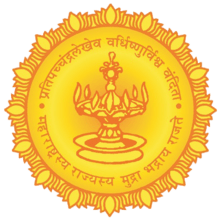Maharashtra
Maharashtra (/mɑːhəˈrɑːʃtrə/; Marathi: [məharaːʂʈrə] (![]()
Maharashtra | |
|---|---|
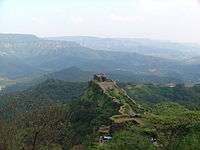  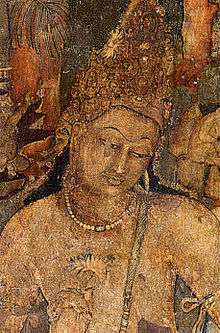 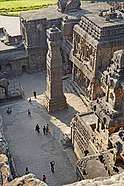     From top, left to right: Pratapgad Fort (near Mahabaleshwar) located in the Western Ghats, Chhatrapati Shivaji Maharaj Terminus, Painting of Padmapani at Ajanta Caves, Kailasa Temple at Ellora Caves, The Gateway of India, Trimurti sculpture of Elephanta Caves, Shaniwar Wada Fort and Hazur Sahib Nanded | |
| Motto(s): Pratipaccandralēkhēva vardhiṣṇurviśva vanditā mahārāṣṭrasya rājyasya mudrā bhadrāya rājatē (The glory of Maharashtra will grow like the first day moon. It will be worshipped by the world and will shine only for the well being of its people.)[1] | |
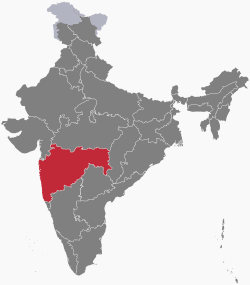 Location of Maharashtra in India | |
| Coordinates (Mumbai): 18.97°N 72.820°E | |
| Country | |
| Formation | 1 May 1960^ (Maharashtra Day) |
| Capitals | Mumbai Nagpur (Winter)[2] |
| Districts | 36 |
| Government | |
| • Body | Government of Maharashtra |
| • Governor | Bhagat Singh Koshyari |
| • Chief Minister | Uddhav Thackeray (SS) |
| • Deputy Chief Minister | Ajit Pawar (NCP) |
| • Legislature | Bicameral |
| • Parliamentary constituency | |
| Area | |
| • Total | 307,713 km2 (118,809 sq mi) |
| Area rank | 3rd |
| Population (2011)[3] | |
| • Total | 112,374,333 |
| • Rank | 2nd |
| • Density | 370/km2 (950/sq mi) |
| Demonym(s) | Maharashtrian |
| GSDP (2019–20) | |
| • Total | ₹28.78 lakh crore (US$400 billion) |
| • Per capita | ₹207,727 (US$2,900) |
| Time zone | UTC+05:30 (IST) |
| ISO 3166 code | IN-MH |
| Vehicle registration | MH |
| Official languages | Marathi[5][6] |
| HDI (2017) | |
| Literacy (2011) | 82.34%[8] |
| Sex ratio (2011) | 929 ♀/1000 ♂[8] |
| Website | Maharashtra.gov.in |
| †The State of Bombay was split into two States i.e. Maharashtra and Gujarat by the Bombay Reorganisation Act 1960[9] †† Common high court | |
| Symbols of Maharashtra | |
| Emblem | |
| Language | |
| Song | "Jai Jai Maharashtra Maza" by Raja Badhe[10] |
| Bird | |
| Insect | |
| Flower | |
| Tree | |
Maharashtra was formed on 1 May 1960 by splitting the bilingual Bombay State, which had existed since 1956, into majority Marathi-speaking Maharashtra and Gujarati-speaking Gujarat, respectively. It has over 112 million inhabitants and its capital, Mumbai, has a population around 18.4 million making it the most populous urban area in India. Nagpur hosts the winter session of the state legislature.[12] Pune is known as the 'Oxford of the East' due to the presence of several well-known educational institutions.[13][14] Nashik is known as the 'Wine Capital of India' as it has the largest number of wineries and vineyards in the country.
The Godavari and the Krishna are the two major rivers in the state. The Narmada and Tapi Rivers flow near the border between Maharashtra and Madhya Pradesh and Gujarat. Maharashtra is the third-most urbanised state of India.[15][16] Prior to Indian independence, Maharashtra was chronologically ruled by the Satavahana dynasty, Rashtrakuta dynasty, Western Chalukyas, Deccan sultanates, Mughals and Marathas, and the British. Ruins, monuments, tombs, forts, and places of worship left by these rulers are dotted around the state. They include the UNESCO World Heritage Sites of the Ajanta and Ellora caves.
Maharashtra is the most industrialised state in India while state capital Mumbai is India's biggest financial and commercial capital.[17] The state has played a significant role in the country's social and political life and widely considered a leader in terms of agricultural and industrial production, trade and transport, and education.[18] Maharashtra is one of the most developed and prosperous Indian states and continues to be the single largest contributor to the national economy with a share of 15% in the country's GDP.[19] The economy of Maharashtra is the largest in India, with a gross state domestic product (GSDP) of ₹28.78 lakh crore (US$400 billion) and has the country's 13th-highest GSDP per capita of ₹207,727 (US$2,900).[4] Maharashtra is the fifteenth-highest ranking among Indian states in human development index.[7]
Etymology
The modern Marathi language developed from the Maharashtri Prakrit,[20] and the word Marhatta (later used for the Marathas) is found in the Jain Maharashtri literature. The terms Maharashtra, Maharashtri, Marathi, and Maratha may have derived from the same root. However, their exact etymology is uncertain.[21]
The most widely accepted theory among the linguistic scholars is that the words Maratha and Maharashtra ultimately derived from a combination of Maha (Marathi: महा) and rashtrika (Marathi: राष्ट्रिका),[21] the name of a tribe or dynasty of petty chiefs ruling in the Deccan region.[22] Another theory is that the term is derived from Maha ("great") and ratha / rathi (chariot / charioteer), which refers to a skilful northern fighting force that migrated southward into the area.[22][23]
An alternative theory states that the term derives from the word Maha ("great") and Rashtra ("nation/dominion").[24] However, this theory is somewhat controversial among modern scholars who believe it to be the Sanskritised interpretation of later writers.[21]
History
Chalcolithic sites belonging to the Jorwe culture (circa 1300–700 BCE) have been discovered throughout the state.[25][26]
Maharashtra was ruled by the Maurya Empire in the fourth and third centuries BCE. Around 230 BCE, Maharashtra came under the rule of the Satavahana dynasty for 400 years.[27] The greatest ruler of the Satavahana dynasty was Gautamiputra Satakarni. In 90 CE, Vedishri,[28] son of the Satavahana king Satakarni, the "Lord of Dakshinapatha, wielder of the unchecked wheel of Sovereignty", made Junnar, 30 miles north of Pune, the capital of his kingdom. The state was also ruled by Western Satraps, Gupta Empire, Gurjara-Pratihara, Vakataka, Kadambas, Chalukya Empire, Rashtrakuta Dynasty, and Western Chalukya before finally, the Yadava rule. The Buddhist Ajanta Caves in present-day Aurangabad display influences from the Satavahana and Vakataka style. The caves were possibly excavated during this period.[29]

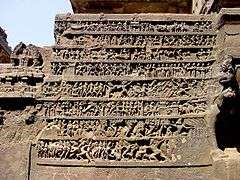
The Chalukya dynasty ruled from the sixth to the eighth centuries CE, and the two prominent rulers were Pulakeshin II, who defeated the north Indian Emperor Harsha, and Vikramaditya II, who defeated the Arab invaders in the eighth century. The Rashtrakuta dynasty ruled Maharashtra from the eighth to the tenth century.[31] The Arab traveller Sulaiman al Mahri described the ruler of the Rashtrakuta Dynasty Amoghavarsha as "one of the four great kings of the world".[32] Shilahara dynasty began as vassals of the Rashtrakuta dynasty which ruled the Deccan plateau between the eighth and tenth centuries. From the early 11th century to the 12th century, the Deccan Plateau, which includes a significant part of Maharashtra, was dominated by the Western Chalukya Empire and the Chola dynasty.[33] Several battles were fought between the Western Chalukya empire and the Chola dynasty in the Deccan Plateau during the reigns of Raja Raja Chola I, Rajendra Chola I, Jayasimha II, Someshvara I, and Vikramaditya VI.[34]
In the early 14th century, the Yadava Dynasty, which ruled most of present-day Maharashtra, was overthrown by the Delhi Sultanate ruler Ala-ud-din Khalji. Later, Muhammad bin Tughluq conquered parts of the Deccan, and temporarily shifted his capital from Delhi to Daulatabad in Maharashtra. After the collapse of the Tughluqs in 1347, the local Bahmani Sultanate of Gulbarga took over, governing the region for the next 150 years.[35] After the break-up of the Bahamani sultanate in 1518, Maharashtra split into five Deccan Sultanates: Nizamshah of Ahmednagar, Adilshah of Bijapur, Qutubshah of Golkonda, Bidarshah of Bidar and Imadshah of Elichpur. These kingdoms often fought with each other. United, they decisively defeated the Vijayanagara Empire of the south in 1565.[36] The present area of Mumbai was ruled by the Sultanate of Gujarat before its capture by Portugal in 1535 and the Faruqi dynasty ruled the Khandesh region between 1382 and 1601 before finally getting annexed by the Mughal Empire. Malik Ambar, the regent of the Nizamshahi dynasty of Ahmednagar from 1607 to 1626,[37] increased the strength and power of Murtaza Nizam Shah II and raised a large army. Malik Ambar is said to have been a proponent of guerrilla warfare in the Deccan region. Malik Ambar assisted Mughal emperor Shah Jahan in Delhi against his stepmother, Nur Jahan, who had ambitions of seating her son-in-law on the throne.[38]
By the early 17th century, Shahaji Bhosale, an ambitious local general who had served Ahmadnagar Sultanate, the Mughals and Adil Shah of Bijapur at different periods during his career, attempted to establish his independent rule.[39] His son Chhatrapati Shivaji Maharaj succeeded in establishing the Maratha Empire which was further expanded during the 18th century by the Bhat family Peshwas based in Pune, Bhonsle of Nagpur, Gaekwad of Baroda, Holkar of Indore, Scindia of Gwalior.[40] At its peak, the empire covered much of the subcontinent, encompassing a territory of over 2.8 million km2. The Marathas are credited to a large extent for ending the Mughal rule in India.[41][42][43] The Marathas defeated the Mughals and conquered large territories in northern and central parts of the Indian subcontinent. After their defeat at the hand of Ahmad Shah Abdali's Afghan forces in the Third Battle of Panipat in 1761, the Maratha suffered a setback. However, the Marathas soon regained lost influence and ruled central and north India including New Delhi until the end of the eighteenth century. The Third Anglo-Maratha War (1817–1818) led to the end of the Maratha Empire and East India Company ruled the country in 1819.[44][45] The Marathas also developed a potent Navy circa 1660s, which at its peak, dominated the territorial waters of the western coast of India from Mumbai to Savantwadi.[46] It would engage in attacking the British, Portuguese, Dutch, and Siddi Naval ships and kept a check on their naval ambitions. The Maratha Navy dominated till around the 1730s, was in a state of decline by the 1770s, and ceased to exist by 1818.[47]
India contains no more than two great powers, British and Maratha, and every other state acknowledges the influence of one or the other. Every inch that we recede will be occupied by them.
— Charles Metcalfe, one of the ablest of the British Officials in India and later acting Governor-General, wrote in 1806
The British East India Company controlled Mumbai beginning in the 17th century, and used it as one of their main trading posts. The Company slowly expanded areas under its rule during the 18th century. Their conquest of Maharashtra was completed in 1818 with the defeat of Peshwa Bajirao II in the Third Anglo-Maratha War.[48]
The British governed western Maharashtra as part of the Bombay Presidency, which spanned an area from Karachi in Pakistan to northern Deccan. A number of the Maratha states persisted as princely states, retaining autonomy in return for acknowledging British suzerainty. The largest princely states in the territory were Nagpur, Satara and Kolhapur; Satara was annexed to the Bombay Presidency in 1848, and Nagpur was annexed in 1853 to become Nagpur Province, later part of the Central Provinces. Berar, which had been part of the Nizam of Hyderabad's kingdom, was occupied by the British in 1853 and annexed to the Central Provinces in 1903.[49] However, a large part called Marathwada remained part of the Nizam's Hyderabad State throughout the British period.
The British ruled for more than a century and brought huge changes in every aspect of life for the people of the Maharashtra region.However, at the turn of the 20th century, the struggle for independence took shape, led by Pune based radical nationalist Bal Gangadhar Tilak and the moderates like Justice Mahadev Govind Ranade, Gopal Krishna Gokhale, Pherozeshah Mehta and Dadabhai Naoroji.Jyotirao Phule was the pioneer of social reform in Maharashtra region in second half of the 19th century. His work for social justice was continued by Shahu, Raja of Kolhapur, at turn of the century and later by Dr. B. R. Ambedkar.. After the partial autonomy given to the states by the Government of India Act 1935, B. G. Kher became the first Chief Minister of the Congress party-led Government of tri-lingual Bombay Presidency.[50] The ultimatum to the British during the Quit India Movement was given in Mumbai, and culminated in the transfer of power and independence in 1947.
After India's independence, the Deccan States, including Kolhapur were integrated into Bombay State, which was created from the former Bombay Presidency in 1950.[51] In 1956, the States Reorganisation Act reorganised the Indian states along linguistic lines, and Bombay Presidency State was enlarged by the addition of the predominantly Marathi-speaking regions of Marathwada (Aurangabad Division) from erstwhile Hyderabad state and Vidarbha region from the Central Provinces and Berar. The southernmost part of Bombay State was ceded to Mysore. From 1954 to 1955 the people of Maharashtra strongly protested against bilingual Bombay state and Samyukta Maharashtra Samiti, was formed.[52][53] The Mahagujarat Movement was started, seeking a separate Gujarat state. Keshavrao Jedhe, S.M. Joshi, Shripad Amrit Dange, Pralhad Keshav Atre and Gopalrao Khedkar fought for a separate state of Maharashtra with Mumbai as its capital under the banner of Samyukta Maharashtra Movement. On 1 May 1960, following mass protests and 105 deaths, the separate Marathi-speaking state was formed by dividing earlier Bombay State into the new states of Maharashtra and Gujarat.[54] The state continues to have a dispute with Karnataka regarding the region of Belgaum and Karwar.[55][56][57]
Geography and climate
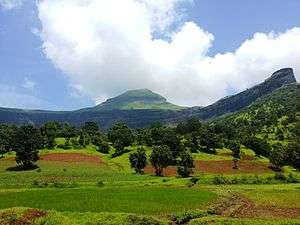
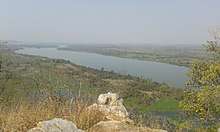
Maharashtra occupies the western and central part of the country and has a long coastline stretching 720 kilometres[58] along the Arabian Sea.[59] One of the more prominent physical features of Maharashtra is the Deccan plateau, which is separated from the Konkan coastline by 'Ghats'.[60] The Ghats are a succession of steep hills, periodically bisected by narrow roads. Most of the famous hill stations of the state are at the Ghats. The Western Ghats (or the Sahyadri Mountain range) provide a physical backbone to the state on the west, while the Satpura Hills along the north and Bhamragad-Chiroli-Gaikhuri ranges on the east serve as its natural borders.[61] The state is surrounded by Gujarat to the north west, Madhya Pradesh to the north, Chhattisgarh to the east, Telangana to the south east, Karnataka to the south and Goa to the south west.[62]
Maharashtra is the third largest state by area in India. Maharashtra has 36 districts, 355 talukas, 535 cities, 63,663 villages, 6 administrative divisions .[63] The Western Ghats better known as Sahyadri, are a hilly range running parallel to the coast, at an average elevation of 1,200 metres (4,000 ft).[60] Kalsubai, a peak in the Sahyadris, near Nashik city is the highest elevated point in Maharashtra.[64] To the west of these hills lie the Konkan coastal plains, 50–80 kilometres in width. To the east of the Ghats lies the flat Deccan Plateau. Forests comprise 17% of the total area of the state.[59] A majority of the forests are in the eastern and Sahyadri regions of the state. The main rivers of the state are Krishna, Bhima, Godavari, Tapi-Purna and Wardha-Wainganga.[59][65] Since the central parts of the state receives low rainfall, most of the rivers in the region have multiple dams. Maharashtra has around 1821 notable large dams.[66]
Maharashtra is divided into five geographic regions. Konkan is the western coastal region, between the Western Ghats and the sea.[67] Kandesh is the north-western region lying in the valley of the Tapti River.[65] Nashik, Jalgaon, Dhule and Bhusawal are the major cities of this region.[68] Desh is in the centre of the state.[69] Marathwada, which was a part of the princely state of Hyderabad until 1956, is located in the southeastern part of the state.[59][70] Aurangabad and Nanded are the main cities of the region.[71] Vidarbha is the easternmost region of the state, formerly part of the Central Provinces and Berar. Nagpur, where the winter session of the state assembly is held, Akola, Amravati and Chandrapur are the main cities in the region.[59] Sahyadri range, with an elevation of 1,000 meters, is known for its crowning plateaus.[72] Lying between the Arabian Sea and the Sahyadri Range, Konkan is narrow coastal lowland, just 50 km wide and with an elevation below 200 meters.[73] The third important region is the Satpura hills along the northern border, and the Bhamragad-Chiroli-Gaikhuri ranges on the eastern border, which form physical barriers preventing easy movement.[59] These ranges also serve as natural limits to the state.[59][74]
Climate
Maharashtra has a tropical climate, with three distinct seasons: Summer (March–May), Monsoon (June–September), and Winter (October–February). However, dew and hail also occur sometimes, depending upon the seasonal weather. The winter between October to February is followed by summer between March and May and the monsoon season between June and September.[75] Summers (March, April and May) are extremely hot, the temperature rises from 22 °C to as high as 43 °C during the summer. The rainfall starts normally in the first week of June. July is the wettest month in Maharashtra, while August also gets substantial rain. The rainy season starts its retreat with the coming of September to the state. Rainfall in Maharashtra differs from region to region. Thane, Raigad, Ratnagiri and Sindhudurg districts, receive heavy rains of an average of 200 centimetres annually. But the districts of Nashik, Pune, Ahmednagar, Dhule, Jalgaon, Satara, Sangli, Solapur and parts of Kolhapur less than 50 centimetres. Rainfall is particularly high in areas adjacent to the Sahyadri mountains such as coastal Konkan on the west and foothills of the mountain range on the eastern side. Central Maharashtra receives less rainfall. However, under the influence of the Bay of Bengal, eastern Vidarbha receives good rainfall in July, August and September.[76] In winter, a cool dry spell occurs, with clear skies, gentle air breeze, and pleasant weather prevails from October to February. But the eastern part of Maharashtra sometimes receives some rainfall. Temperature rise from 12 °C to 34 °C during this season.
Biodiversity
| Animal | Indian giant squirrel | |
| Bird | Yellow-footed green pigeon | |
| Tree | Mango Tree | |
| Flower | Jarul | |
| Butterfly | Blue mormon |
Flora of Maharashtra is heterogeneous in composition. In 2012 the recorded thick forest area in the state was 61,939 km2 (23,915 sq mi) which was about 20.13% of the state's geographical area.These[78] There are three main Public Forestry Institutions (PFIs) in the Maharashtra state: the Maharashtra Forest Department (MFD), the Forest Development Corporation of Maharashtra (FDCM) and the Directorate of Social Forestry (SFD).[79] The Maharashtra State Biodiversity Board, constituted by the Government of Maharashtra in January 2012 under the Biological Diversity Act, 2002, is the nodal body for conservation of biodiversity within and outside forest areas in the State.[80][81]
According to the Champion and Seth classification, Maharashtra has five types of forests:[82]
- Southern Tropical Semi-Evergreen Forests:These are found in the western ghats at height of 400–1000 meters.Some of the species of trees found in this type of forests are Anjani, Hirda, Kinjal, and Mango.
- Southern Tropical Moist Deciduous Forests:Two main sub-types occur under this group. i) Moist Teak bearing Forests:These forests are found in Melghat,[83] other districts in Vidarbha and Thane district.Commercially important Teak, Shishum and bamboo are found here. ii) Moist Mixed deciduous Forests:In addition to evergreen Teak, some of the other tree species found in this type of forests include Jambul, Ain, and Shisam.
- Southern Tropical Dry Deciduous Forests. Forests of this type occupy a major part of the state. Two types of occur under this group. i) Dry Teak Bearing Forests and ii) Moist Mixed deciduous Forests
- Southern Tropical Thorn Forests:These are found in the low rainfall regions of Marathwada, Vidarbha, Khandesh and Western Maharashtra. At present, these forests are heavily degraded. Babul, Bor, and Palas are some of the tree species found here.
- Littoral and Swamp Forests: These are mainly found in the Creeks of Sindhudurg and Thane districts of the coastal Konkan region. These forests are important for the protection of the coastal environment
In addition to the above forest types, Maharashtra harbours significant mangrove, coastal and marine biodiversity, with 304 km2 of area under mangrove cover as per the India State of Forest Report (ISFR) of the Forest survey India.[84] Some of the forest areas have been converted into wildlife reserves, thus preserving their biodiversity.[85] Western ghats of Maharashtra are included in the 34 global Biodiversity hotspots owing to its extraordinarily rich biodiversity. The biodiversity includes more than five hundred species of birds.[86] Similarly a study in the Amravati region found 171 species of birds. Both regions include resident as well as migrant species.[87] The state has three game reserves, as well as several national parks and bird sanctuaries.[88] The six tiger reserves located in the state cover a total area of 9133 km2. Wildlife sanctuaries in the state include Bhimashankar Wildlife Sanctuary, Radhanagari Wildlife Sanctuary, Bor Wildlife Sanctuary, Koyna Wildlife Sanctuary, Chandoli National Park, Sanjay Gandhi National Park, Nagzira Wildlife Sanctuary, Navegaon National Park and Mhadei Wildlife Sanctuary.[89] The most common animal species present in the state are tiger, leopard, gaur, sloth bear, sambar, four-horned antelope, blue bull, chital, barking deer, mouse deer, small Indian civet, golden jackal, jungle cat, striped hyena, and hare.[90] Other animals in the state include reptiles such as lizards, cobras and kraits.[88] The national parks of Maharashtra possess a variety of plant species that include jamun, palas, shisam, neem, teak, dhawada, kalam, ain, bija, shirish, mango, acacia, awala, kadamba, moha, terminalia, hedu and ficus.[83]
Regions, divisions and districts
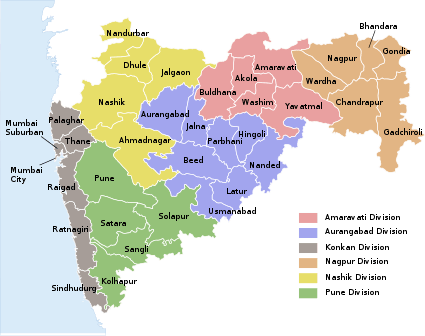
Maharashtra consists of six administrative divisions:[91]
- Amravati
- Aurangabad
- Mumbai
- Nagpur
- Nashik
- Pune
The state's six divisions are further divided into 36 districts, 109 sub-divisions and 358 talukas.[92] Maharashtra's top five districts by population, as ranked by the 2011 Census, are listed in the following table.
Each district is governed by a district collector or district magistrate, appointed either by the Indian Administrative Service or the Maharashtra Civil Service.[93] Districts are subdivided into sub-divisions (Taluka) governed by sub-divisional magistrates, and again into blocks.[94] A block consists of panchayats (village councils) and town municipalities.[95][96] Talukas are intermediate level panchayat between the Zilla Parishad (district councils) at the district level and gram panchayat (village councils) at the lower level.[94][97]
Demographics
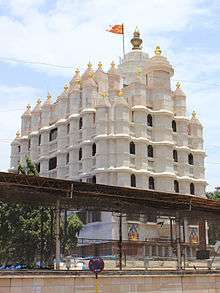
| Population growth | |||
|---|---|---|---|
| Census | Population | %± | |
| 1901 | 19,392,000 | — | |
| 1911 | 21,475,000 | 10.7% | |
| 1921 | 20,850,000 | −2.9% | |
| 1931 | 23,959,000 | 14.9% | |
| 1941 | 26,833,000 | 12.0% | |
| 1951 | 32,003,000 | 19.3% | |
| 1961 | 39,554,000 | 23.6% | |
| 1971 | 50,412,000 | 27.5% | |
| 1981 | 62,784,000 | 24.5% | |
| 1991 | 78,937,000 | 25.7% | |
| 2001 | 96,752,000 | 22.6% | |
| 2011 | 112,373,000 | 16.1% | |
| Source:Census of India[98] | |||
According to the provisional results of the 2011 national census, Maharashtra is the richest state in India and second most populous state in India with a population of 112,374,333 (9.28% of India's population) of which male and female are 58,243,056 and 54,131,277, respectively. The total population growth in 2011 was 15.99 percent while in the previous decade it was 22.57 percent.[100][101] Since independence, the decadal growth rate of population has remained higher (except in the year 1971) than the national average. For the first time, in the year 2011, it was found to be lower than the national average.[101] The 2011 census for the state found 55% of the population to be rural with 45% being urban based.[102][103]
Bihari, Gujarati, Sindhis, Punjabis, Parsis, Marwari, Kannada, Telugu and Tamil minorities are scattered throughout the state. The 2011 census found scheduled castes and scheduled tribes to account for 11.8 and 8.9% of the population, respectively.[104] The scheduled tribes include adivasis such as Thakar, Warli, Konkana and Halba.[105]
According to the 2011 census, Hinduism was the principal religion in the state at 79.8% of the total population, while Muslims constituted 11.5% of the total population. Buddhism accounted for 5.8% in Maharashtra's total population, with 6,531,200 followers, which is 77.36% of all Buddhists in India. Sikhs, Christians and Jains constituted 0.2%, 1.0%, 1.2% of the population, respectively.[99]
The state contributes 9.28% to India's population.[106] The sex ratio in Maharashtra was 929 females per 1000 males, which was below the national average of 943.[8] The density of Maharashtra was 365 inhabitants per km2 which was lower than national average 382 per km2. Since 1921, the populations of Ratnagiri and Sindhudurg shrank by −4.96% and −2.30%, respectively, while the population of Thane grew by 35.9%, followed by Pune at 30.3%. The literacy rate rose to 83.2%.[107] Of this, male literacy stood at 89.82% and female literacy 75.48%.
Language
The official language is Marathi[110][5] although different regions have their own dialects.[111] It is native to the Maharashtra state, and is its main language.
Over 83.1 million people speak Marathi, making it the third-most spoken language in India, and 10th most-spoken native language in the world.[112]
English is also spoken in Maharashtra, mostly in urban areas. Spoken Marathi language varies by district, area or locality in its tone and a few words. Konkani, Kannada, Tulu and Gujarati are also spoken in some areas. Other major dialects include Varhadi spoken in the Vidarbha region and Dangi spoken near the Maharashtra-Gujarat border. The sound /l/ is abundantly used in many verbs and nouns in Marathi. It is replaced by the sound /j/ in the Varhadi dialect, which makes it quite distinct. According to the economic survey of Maharashtra (2008–09), the percentage of the state's population that names Marathi as its mother tongue has declined to 68.8% from 76.5% over the past three decades, while there has been a sharp rise in the Hindi-speaking population (11% from 5%) in the same period.[114]
Governance and Administration
State government
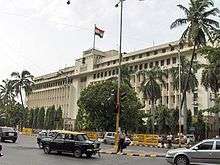
Maharashtra has a parliamentary system of government with two democratically elected houses, the Legislative Assembly and the Legislative Council. The Maharashtra Legislative Assembly (Vidhan Sabha) consists of 288 members who are elected for five-year terms.[115] The Maharashtra Legislative Council (Vidhan Parishad) is a permanent body of 78 members with a third of members replaced every two years. The government of Maharashtra is headed by the Chief Minister, who is chosen by the party or coalition holding the majority in the Legislative Assembly. The Chief Minister, along with the council of ministers, drives the legislative agenda and exercises most of the executive powers.[116] However, the constitutional and formal head of the state is the Governor, who is appointed for a five-year term by the President of India on the advice of the Union government.[117]
Politics
The politics of the state since its formation in 1960 have been dominated by the Indian National Congress party. Maharashtra became a bastion of the Congress party producing stalwarts such as Yashwantrao Chavan, Vasantdada Patil, Vasantrao Naik and Shankarrao Chavan. Sharad Pawar has been a towering personality in the state and National politics for over forty years. During his career, he has split the Congress twice with significant consequences for the state politics.[118][119] The Congress party enjoyed a near unchallenged dominance of the political landscape until 1995 when the Shiv Sena and the Bharatiya Janata Party (BJP) secured an overwhelming majority in the state to form a coalition government.[120] After his second parting from the Congress party in 1999, Sharad Pawar formed the NCP but formed a coalition with the Congress to keep out the BJP-Shivsena combine out of the government for fifteen years until September 2014. Prithviraj Chavan of the Congress party was the last Chief Minister of Maharashtra under the Congress / NCP alliance.[121][122][123] For the 2014 assembly polls, the two alliances between NCP and Congress and that between BJP and Shivsena respectively broke down over seat allocations. In the election, the largest number of seats went to the Bharatiya Janata Party, with 122 seats. The BJP initially formed a minority government under Devendra Fadnavis.The Shiv sena entered the Government after two months, and provided a comfortable majority for the alliance in the Maharashtra Vidhansabha.[124] In 2019 Lok sabha elections, the BJP-Shiv Sena alliance secured 41 seat out 48 from the state.[125] Later in 2019, the BJP and Shiv Sena alliance fought the assembly elections together but the alliance broke down after the election over the post of chief minister. Uddhav Thackeray of Shiv Sena then formed an alternative governing coalition under his leadership with his erstwhile opponents from NCP, INC, and a number of independent members of legislative assembly.[126][127] On 28 November 2019, Thackeray took oath as 19th Chief minister of Maharashtra after being elected as the president of the newly formed post-poll coalition Maha Vikas Aghadi.[128][129][130]
State representation in Indian Parliament
The people of Maharashtra also elect 48 members to the Lok Sabha, the lower house of the Indian Parliament. In the 2014 general elections, the National Democratic Alliance (NDA), consisting of the Bharatiya Janata Party, the Shiv Sena, and Swabhimani Paksha, won 23, 18, and 1 seats, respectively.[131] The NDA retained its dominance in the state by winning 41 out of the 48 seats in the 2019 Lok Sabha elections.[132] The members of the state Legislative Assembly elect 19 members to the Rajya Sabha, the upper house of the Indian Parliament.[133]
Local government
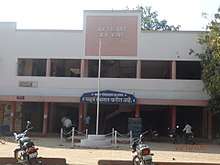
The state has a long tradition of highly powerful planning bodies at district and local levels. Local self governance institutions in rural areas include 34 zilla parishads (district councils), 355 Taluka Panchayat samitis (district Sub-division councils) and 27,993 Gram panchayats (village councils). Urban areas in the state are governed by 27 Municipal Corporations, 222 Municipal Councils, four Nagar Panchayats and seven Cantonment Boards.[101][134] Although Maharashtra had Gram panchayat with elected members since 1961, the 73rd amendment to the Indian constitution of 1993 put in place a statutory requirement of 33% of seats on the panchayats reserved for women.In addition, 33% of the sarpanch (panchayat chief) positions were also reserved for women.[135] Although the amendment boosted the number of women leaders at the village level, there have been cases of harassment by male members of the panchayat towards the female members of the organisations.[136] The administration in each district is headed by a District Collector, who belongs to the Indian Administrative Service and is assisted by a number of officers belonging to Maharashtra state services.[137] The Superintendent of Police, an officer belonging to the Indian Police Service and assisted by the officers of the Maharashtra Police Service, maintains law and order in addition to other related issues in each district. The Divisional Forest Officer, an officer belonging to the Indian Forest Service, manages the forests, environment, and wildlife of the district, assisted by the officers of Maharashtra Forest Service and Maharashtra Forest Subordinate Service.[138] Sectoral development in the districts is looked after by the district head of each development department, such as Public Works, Health, Education, Agriculture and Animal Husbandry.[139][140]
Judiciary
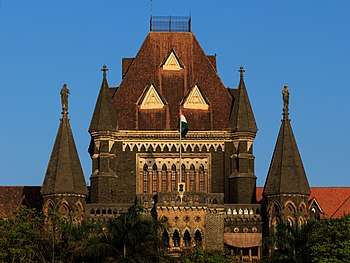
The judiciary in the state consists of the Maharashtra High Court (The High Court of Bombay), district and session courts in each district and lower courts and judges at the taluka level.[141] The High Court has regional branches at Nagpur and Aurangabad in Maharashtra and Panaji which is the capital of Goa.[142] The state cabinet on 13 May 2015 passed a resolution favouring the setting up of one more bench of the Bombay high court in Kolhapur, covering the region.[143] The President of India appoints the chief justice of the High Court of the Maharashtra judiciary on the advice of the chief justice of the Supreme Court of India as well as the Governor of Maharashtra.[144] Other judges are appointed by the chief justice of the high court of the judiciary on the advice of the Chief Justice.[145] Subordinate Judicial Service is another vital part of the judiciary of Maharashtra.[146] The subordinate judiciary or the district courts are categorised into two divisions: the Maharashtra civil judicial services and higher judicial service.[147] While the Maharashtra civil judicial services comprises the Civil Judges (Junior Division)/Judicial Magistrates and civil judges (Senior Division)/Chief Judicial Magistrate, the higher judicial service comprises civil and sessions judges.[148] The Subordinate judicial service of the judiciary is controlled by the District Judge.[145][149]
Economy
| Net State Domestic Product at Factor Cost at Current Prices (2004–05 Base)[150]
figures in crores of Indian rupees | |
| Year | Net State Domestic Product |
|---|---|
| 2004–2005 | ₹3.683 trillion (US$52 billion) |
| 2005–2006 | ₹4.335 trillion (US$61 billion) |
| 2006–2007 | ₹5.241 trillion (US$73 billion) |
| 2007–2008 | ₹6.140 trillion (US$86 billion) |
| 2008–2009 | ₹6.996 trillion (US$98 billion) |
| 2009–2010 | ₹8.178 trillion (US$110 billion) |
| 2013–2014 | ₹15.101 trillion (US$210 billion) |
| 2014–2015 | ₹16.866 trillion (US$240 billion) |
The economy of Maharashtra is driven by manufacturing, international trade, Mass Media (television, motion pictures, video games, recorded music), aerospace, technology, petroleum, fashion, apparel, and tourism.[151] Maharashtra is the most industrialised state and has maintained the leading position in the industrial sector in India.[152] The State is pioneer in small scale industries.[153] Mumbai, the capital of state and the financial capital of India, houses the headquarters of most of the major corporate and financial institutions. India's main stock exchanges and capital market and commodity exchanges are located in Mumbai. The State continues to attract industrial investments from domestic as well as foreign institutions. Maharashtra has the largest proportion of taxpayers in India and its share markets transact almost 70 per cent of the country's stocks.[154]
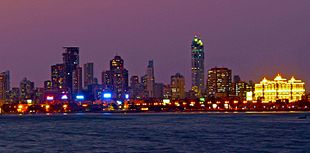
The Service sector dominates the economy of Maharashtra, accounting for 61.4% of the value addition and 69.3% of the value of output in the state.[155] The state's per-capita income is 40% higher than the all-India average.[156] The gross state domestic product (GSDP) at current prices for 2011–12 is estimated at 11,995.48 billion and contributes about 14.4% of the GDP.[157] The agriculture and allied activities sector contributes 12.9% to the state's income.[158][159] Net State Domestic Product (State Income), as per the first revised estimates was 10,827.51 billion and Per Capita State Income was 95,339 during 2011–12. The percentage of fiscal deficit to GSDP was 1.7 per cent and debt stock to GSDP was 18.4 per cent during 2012–13, well within Consolidated Fiscal Reform Path stipulated by the Thirteenth Finance Commission. In 2012, Maharashtra reported a revenue surplus of ₹1524.9 million (US$24 million), with a total revenue of ₹1,367,117 million (US$22 billion) and a spending of ₹1,365,592.1 million (US$22 billion).[155] Maharashtra ranks first in FDI equity and percentage share of total FDI inflows is 32.27%.[158] Total FDI inflows into Maharashtra are US$53.48 billion.[155] Top countries that invested FDI equity in Maharashtra (from January 2000 to December 2011) were Mauritius (39%), Singapore (10%), United Kingdom (10%), United States (7%) and Netherlands (5%).[155]
Maharashtra contributes 25% of the country's industrial output[160] and is the most indebted state in the country.[161][162] Industrial activity in state is concentrated in four districts: Mumbai City, Mumbai Suburban, Thane and Pune.[163] Mumbai has the largest share in GSDP (21.5 per cent), both Thane and Pune districts contribute about same in the Industry sector, Pune district contributes more in the agriculture and allied activities sector, whereas Thane district contributes more in the Services sector.[163] Nashik district shares highest in the agricultural and allied activities sector, but is far behind in the Industry and Services sectors as compared to Thane and Pune districts.[163] Industries in Maharashtra include chemical and chemical products (17.6%), food and food products (16.1%), refined petroleum products (12.9%), machinery and equipment (8%), textiles (6.9%), basic metals (5.8%), motor vehicles (4.7%) and furniture (4.3%).[164] Maharashtra is the manufacturing hub for some of the largest public sector industries in India, including Hindustan Petroleum Corporation, Tata Petrodyne and Oil India Ltd.[165]
Maharashtra has an above average knowledge industry in India with the Pune Metropolitan area being the leading IT hub in the state. Approximately 25% of the top 500 companies in the IT sector are situated in Maharashtra.[166] The state accounts for 28% of the software exports of India.[166] The state houses important financial institutions such as the Reserve Bank of India, the Bombay Stock Exchange, the National Stock Exchange of India, the SEBI and the corporate headquarters of numerous Indian companies and multinational corporations. It is also home to some of India's premier scientific and nuclear institutes like BARC, NPCL, IREL, TIFR, AERB, AECI, and the Department of Atomic Energy.[163]
The banking sector comprises scheduled and non-scheduled banks.[166] Scheduled banks are of two types, commercial and co-operative. Scheduled Commercial Banks (SCBs) in India are classified into five types: State Bank of India and its associates, nationalised banks, private sector banks, Regional Rural Banks and others (foreign banks). In 2012, there were 9,053 banking offices in the state, of which about 26 percent were in rural and 54 percent were in urban areas. Maharashtra has a microfinance system, which refers to small scale financial services extended to the poor in both rural and urban areas. It covers a variety of financial instruments, such as lending, savings, life insurance, and crop insurance.[167] Three largest urban cooperative banks in India are all based in Maharashtra.[168]
With more than half the population being rural, agriculture and allied industries play an important role in the states's economy. The agriculture and allied activities sector contributes 12.9% to the state's income. Staples such as rice and millet are the main monsoon crops. Important cash crops include sugarcane, cotton, oilseeds, tobacco, fruit, vegetables and spices such as turmeric.[61] Animal husbandry is an important agriculture related activity. The State's share in the livestock and poultry population in India is about 7% and 10% respectively. Maharashtra was a pioneer in the development of Agricultural Cooperative Societies after independence. In fact, it was an integral part of the then Governing Congress party's vision of ‘rural development with local initiative’. A ‘special’ status was accorded to the sugar cooperatives and the government assumed the role of a mentor by acting as a stakeholder, guarantor and regulator,[169][170][171] Apart from sugar, Cooperatives play a crucial role in dairy,[172] cotton, and fertiliser industries.
Transport
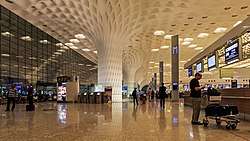
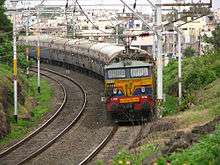
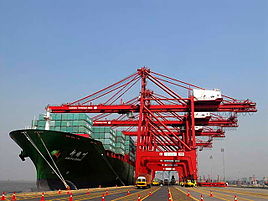
The state has a large, multi-modal transportation system with the largest road network in India.[173] In 2011, the total length of surface road in Maharashtra was 267,452 km;[174] national highways comprised 4,176 km[175] and state highways 3,700 km.[174] The Maharashtra State Road Transport Corporation (MSRTC) provides economical and reliable passenger road transport service in the public sector.[176] These buses, popularly called ST (State Transport), are the preferred mode of transport for much of the populace. Hired forms of transport include metered taxis and auto rickshaws, which often ply specific routes in cities. Other district roads and village roads provide villages accessibility to meet their social needs as well as the means to transport agricultural produce from villages to nearby markets. Major district roads provide a secondary function of linking between main roads and rural roads. Almost 98% of villages are connected via the highways and modern roads in Maharashtra. Average speed on state highways varies between 50–60 km/h (31–37 mi/h) due to heavy presence of vehicles; in villages and towns, speeds are as low as 25–30 km/h (15–18 mi/h).[177]
The first passenger train in India ran from Mumbai to Thane on 16 April 1853.[178] Rail transportation is run by Central Railway, Western Railway, South Central Railway and South East Central Railway zones of the Indian Railways with the first two zones being headquartered in Mumbai, at Chhatrapati Shivaji Maharaj Terminus (CSMT) and Churchgate respectively and Konkan Railway which is headquartered in Navi Mumbai.[179][180] The Mumbai Rajdhani Express, the fastest rajdhani train, connects the Indian capital of New Delhi to Mumbai.[181] Thane and CSMT are the busiest railway stations in India,[182] the latter serving as a terminal for both long-distance trains and commuter trains of the Mumbai Suburban Railway.
The two principal sea ports, Mumbai Port and Jawaharlal Nehru Port, which is also in the Mumbai region, are under the control and supervision of the government of India.[183] There are around 48 minor ports in Maharashtra.[184] Most of these handle passenger traffic and have a limited capacity. None of the major rivers in Maharashtra are navigable and so river transport does not exist in the state.
Almost all the major cities of Maharashtra have airports. CSIA (formerly Bombay International Airport) and Juhu Airport are the two airports in Mumbai. The two other international airports are Pune International Airport and Dr. Babasaheb Ambedkar International Airport at Nagpur. While Aurangabad Airport is a domestic airport operated by Airports Authority of India. Flights are operated by both private and government airline companies.
Most of the State's airfields are operated by the Airports Authority of India (AAI) while Reliance Airport Developers (RADPL), currently operate five non-metro airports at Latur, Nanded, Baramati, Osmanabad and Yavatmal on a 95-year lease.[185] The Maharashtra Airport Development Company (MADC) was set up in 2002 to take up development of airports in the state that are not under the AAI or the Maharashtra Industrial Development Corporation (MIDC). MADC is playing the lead role in the planning and implementation of the Multi-modal International Cargo Hub and Airport at Nagpur (MIHAN) project.[186] Additional smaller airports include Akola, Amravati, Chandrapur, Dhule, Gondia, Jalgaon, Karad, Kolhapur, Nashik Road, Ratnagiri, and Solapur.[187]
Education and social development
Census of 2011 showed literacy rates in the state for males and females were around 78% and 67% respectively.[188]
History
Scottish missionary John Wilson, Indian nationalists such as Vasudev Balwant Phadke and Bal Gangadhar Tilak, social reformers such as Jyotirao Phule, Dhondo Keshav Karve and Bhaurao Patil all played a leading role in the setting up of modern schools and colleges during the British colonial era .[189][190][191][192] The forerunner of Deccan College Post-Graduate and Research Institute was established in 1821. The Shreemati Nathibai Damodar Thackersey Women's University, the oldest women's liberal arts college in south Asia, started its journey in 1916. College of Engineering Pune, established in 1854, is the third oldest college in Asia.[193] Government Polytechnic Nagpur, established in 1914, is one of the oldest polytechnic in India.[194]
Primary and secondary level
.jpg)
Maharashtra schools are run by the state government or by private organisations, including religious institutions. Instruction is mainly in Marathi, English or Hindi, though Urdu is also used. The secondary schools are affiliated with the Council for the Indian School Certificate Examinations (CISCE), the Central Board for Secondary Education (CBSE), the National Institute of Open School (NIOS) or the Maharashtra State Board of Secondary and Higher Secondary Education. Under the 10+2+3 plan, after completing secondary school, students typically enroll for two years in a junior college, also known as pre-university, or in schools with a higher secondary facility affiliated with the Maharashtra State Board of Secondary and Higher Secondary Education or any central board. Students choose from one of three streams, namely liberal arts, commerce or science. Upon completing the required coursework, students may enroll in general or professional degree programs.
Tertiary level
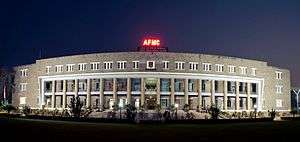
Maharashtra has 24 universities with a turnout of 160,000 Graduates every year.[195][196] Maharashtra has played a pioneering role in the development of the modern education system in India. The University of Mumbai, is the largest university in the world in terms of the number of graduates and has 141 affiliated colleges.[197] According to prominent national rankings, 5 to 7 Maharashtra colleges and universities are ranked among the top 20 in India.[198][199][200] Maharashtra is also home to such notable autonomous institutes as Indian Institute of Technology Bombay, Dr. Babasaheb Ambedkar Technological University, Institute of Chemical Technology, Homi Bhabha National Institute, Walchand College of Engineering, Visvesvaraya National Institute of Technology (VNIT) and Veermata Jijabai Technological Institute (VJTI), Sardar Patel College of Engineering (SPCE).[201] Most of these autonomous institutes are ranked the highest in India and have very competitive entry requirements. The University of Pune (now Savitribai Phule Pune University), the National Defence Academy, Film and Television Institute of India, Armed Forces Medical College and National Chemical Laboratory were established in Pune soon after the Indian independence in 1947. Mumbai has an IIT, has National Institute of Industrial Engineering and Nagpur has IIM and AIIMS.
Some of the notable institutes in the state are: Maharashtra National Law University, Nagpur (MNLUN), Maharashtra National Law University, Mumbai (MNLUM), Maharashtra National Law University, Aurangabad (MNLUA), Government Law College, Mumbai (GLC), ILS Law College, and Symbiosis Law School (SLS).
Maharashtra has hundreds of other private colleges and universities, including many religious and special-purpose institutions. Most of the private colleges were set up in the last thirty years after the State Government of Vasantdada Patil liberalised the Education Sector in 1982.[202] Politicians and leaders involved in the huge cooperative movement in Maharashtra were instrumental in setting up the private institutes[203][204] There are also local community colleges with generally more open admission policies, shorter academic programs, and lower tuition.
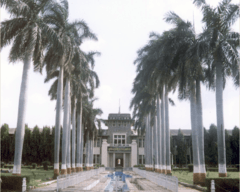
The state also has four agricultural universities namely Vasantrao Naik Marathwada Agricultural University, Mahatma Phule Krishi Vidyapeeth, Dr. Panjabrao Deshmukh Krishi Vidyapeeth and Dr. Balasaheb Sawant Konkan Krishi Vidyapeeth,[205] besides these, there are other regional universities like Sant Gadge Baba Amravati University, Dr. Babasaheb Ambedkar Marathwada University, North Maharashtra University, Shivaji University, Solapur University, Swami Ramanand Teerth Marathwada University and Rashtrasant Tukadoji Maharaj Nagpur University, all well established and nationally renowned, to cover the educational needs at the district levels of the state. Apart from this, there are a number of deemed universities in Maharashtra, including Symbiosis International University, Tata Institute of Social Sciences, and Tilak Maharashtra University.[206]
Vocational training
The state has many post-secondary school industrial training institutes (ITIs) run by the government and private trusts that offer vocational training in numerous trades such as construction, plumbing, welding, automobile mechanic etc. Successful candidates receive the National Trade Certificate.[207]
Infrastructure
Healthcare
In 2011, the health care system in Maharashtra consisted of 363 rural government hospitals,[208] 23 district hospitals (with 7,561 beds), 4 general hospitals (with 714 beds) mostly under the Maharashtra Ministry of Health and Family Welfare, and 380 private medical establishments; these establishments provide the state with more than 30,000 hospital beds.[209] It is the first state in India to have nine women's hospitals serving 1,365 beds.[209] The state also has significant number of medical practitioners who hold the Bachelor of Ayurveda, Medicine and Surgery qualifications. These practitioners primarily use the traditional Indian therapy of Ayurveda but can use modern western medicine as well.[210]
In Maharashtra as well as in rest of India, Primary Health Centre (PHC) are part of the government-funded public health system and are the most basic units of the healthcare system. They are essentially single-physician clinics usually with facilities for minor surgeries, too. [211]The government of India in 2018 launched the Ayushman Bharat Yojana scheme.The Maharashtra declined to join because the state had its own state healthcare programme.[212] That program called Mahatma Jyotiba Phule Jan Arogya Yojana was already functioning well. The state later joined Ayushman Bharat Yojana with special exceptions to make it part of its existing infrastructure.[212] the initiative has two components- the National Health Protection Scheme and the Health and Wellness Centres (HWCs).Under the scheme,PHC have been converted to HWC and presently there are 248 in the state.[213]
Maharashtra has a life expectancy at birth of 67.2 years in 2011, ranking it third among 29 Indian states.[214] The total fertility rate of the state is 1.9.[215] The Infant mortality rate is 28 and the maternal mortality ratio is 104 (2012–2013), which are lower than the national averages.[216][217] Public health services are governed by the Ministry of Health and Family Welfare (MoHFW), through various departments. The Ministry is divided into two departments: the Public Health Department, which includes family welfare and medical relief, and the Department of Medical Education and Drugs.[218][219]
In Maharashtra, health insurance includes any program that helps pay for medical expenses, whether through privately purchased insurance, social insurance or a social welfare program funded by the government.[220] In a more technical sense, the term is used to describe any form of insurance that provides protection against the costs of medical services.[221] This usage includes private insurance and social insurance programs such as National Health Mission, which pools resources and spreads the financial risk associated with major medical expenses across the entire population to protect everyone, as well as social welfare programs such as National Rural Health Mission (NRHM) and the Health Insurance Program, which provide assistance to people who cannot afford health coverage.[220][221][222]
Energy
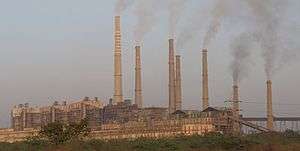
Although its population makes Maharashtra one of the country's largest energy users,[223][224] conservation mandates, mild weather in the largest population centres and strong environmental movements have kept its per capita energy use to one of the smallest of any Indian state.[225] The high electricity demand of the state constitutes 13% of the total installed electricity generation capacity in India, which is mainly from fossil fuels such as coal and natural gas.[226] Mahavitaran is responsible for distribution of electricity throughout the state by buying power from Mahanirmiti, captive power plants, other state electricity boards and private sector power generation companies.[225]
As of 2012, Maharashtra was the largest power generating state in India, with installed electricity generation capacity of 26,838 MW.[224] The state forms a major constituent of the western grid of India, which now comes under the North, East, West and North Eastern (NEWNE) grids of India.[223] Maharashtra Power Generation Company (MAHAGENCO) operates thermal power plants.[227] In addition to the state government-owned power generation plants, there are privately owned power generation plants that transmit power through the Maharashtra State Electricity Transmission Company, which is responsible for transmission of electricity in the state.[228]
Culture
Cuisine
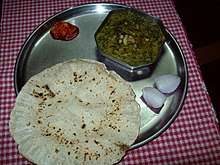
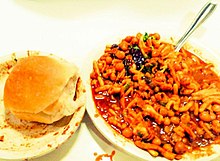
Maharashtra cuisine covers a range from mild to very spicy dishes. Wheat, rice, jowar, bajri, vegetables, lentils and fruit form staple food of the Maharashtrian diet. Some of the popular traditional dishes include puran poli, ukdiche modak, and batata wada. Misal Pav, Pav Bhaji and Vada pav are dishes that became very popular in the last fifty years.[231] Meals (mainly lunch and dinner) are served on a plate called thali. Each food item served on the thali has a specific place. In some households, meals begin with a thanksgiving offering of food (Naivedya) to the household Gods. Maharashtrian cuisine has many regional varieties including Malvani (Konkani),Kolhapuri and Varhadhi.[232] Though quite different, both use a lot of seafood and coconut.[233] The staple foods of the Konkani people are rice and fish
The bhaajis are vegetable dishes made with a particular vegetable or a combination. They require the use of goda (sweet) masala, essentially consisting of some combination of coconut, onion, garlic, ginger, red chilli powder, green chillies and mustard.[231] Depending on the caste or specific religious tradition of a family, onion and garlic may not be used in cooking.[232] A particular variant of bhaaji is the rassa or curry.[234] Vegetarians prepare rassa or curry of potatoes and or cauliflower with tomatoes or fresh coconut kernel and plenty of water to produce a soup-like preparation rather than bhaaji. Varan is nothing but plain dal, a common Indian lentil stew. Aamti is variant of the curry, typically consisting of a lentil (tur) stock, flavoured with goda masala, tamarind or amshul, and jaggery (gul).[231]
Among seafood, the most popular fish is bombil or the Bombay duck.[233] All non-vegetarian and vegetarian dishes are eaten with boiled rice, chapatis or with bhakris, made of jowar, bajra or rice flours. Special rice puris called vada and amboli, which is a pancake made of fermented rice, urad dal, and semolina, are also eaten as a part of the main meal.[232]
Attire
Traditionally, Marathi women commonly wore the sari, often distinctly designed according to local cultural customs.[235] Most middle aged and young women in urban Maharashtra dress in western outfits such as skirts and trousers or shalwar kameez with the traditionally nauvari or nine-yard lugade,[236] disappearing from the markets due to a lack of demand.[237] Older women wear the five-yard sari. In urban areas, the five-yard sari, especially the Paithani, is worn by younger women for special occasions such as marriages and religious ceremonies.[238] Among men, western dressing has greater acceptance. Men also wear traditional costumes such as the dhoti, and pheta[239] on cultural occasions. The Gandhi cap is the popular headgear among older men in rural Maharashtra.[235][240][241] The Kurta (a long shirt) is worn by men on special occasions. Women wear traditional jewelries derived from Maratha and Peshwa dynasties. Kolhapuri saaj, a special type of necklace, is also worn by Marathi women.[235] In urban areas, many women and men wear western attire.[241]
Performing arts
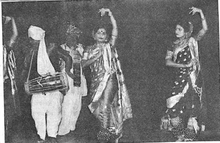
Maharashtrian artists have made major contributions to Indian Classical music. Its vibrant folk form includes Powada, Bharuds and Gondhals.[242] Cities like Kolhapur and Pune have been playing a major role in preservation of music like Bhavageet and Natya Sangeet, which are inherited from Indian classical music. The songs from Hindi films and Marathi films are popular in urban areas.
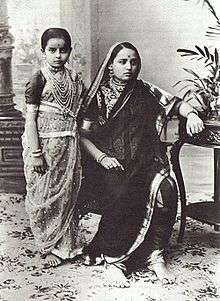
Marathi dance forms draw from folk traditions. Lavani is popular form of dance in the state. The Bhajan, Kirtan and Abhangas of the Varkari sect (Vaishanav Devotees) have a long history and are part of their daily rituals.[243][244] Koli dance (as called 'Koligeete') is among the most popular dances of Maharashtra. As the name suggests, it is related to the fisher folk of Maharashtra, who are called Kolis. Popular for their unique identity and liveliness, their dances represent their occupation. This type of dance is represented by both men and women. While dancing, they are divided into groups of two. These fishermen display the movements of waves and casting of the nets during their koli dance performances.,[245][246]
Literature
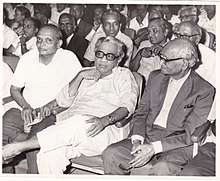
Maharashtra's regional literature is about lives and circumstances of Marathi people in specific parts of the state. The Marathi language, which boasts a rich literary heritage, is written in the Devanagari script.[247] The earliest instances of Marathi literature is by Sant Dnyaneshwar with his Bhawarthadeepika (popularly known as Dnyaneshwari). The compositions, written in the 13th century, are spiritually inclined. Other compositions are by Bhakti saints such as Tukaram, Eknath, Namdev, Ramdas, and Gora Kumbhar.[248] Their compositions are mostly in poetic form, which are called Abhang. Maharashtra has a long tradition in spiritual literature, evidenced by the Amrutanubhav, Bhavarth Deepika, Bhagavata Purana, Eknathi Bhagwat and Bhavarth Ramayan.[249]
19th century Marathi literature includes the works of authors such as Balshastri Jambhekar, Gopal Ganesh Agarkar, Bal Gangadhar Tilak, Gopal Hari Deshmukh, Mahadev Govind Ranade, Jyotirao Phule, Babasaheb Ambedkar, Vinayak Damodar Sawarkar, Ram Ganesh Gadkari, Tryambak Bapuji Thombre, Hari Narayan Apte, Vishnushastri Chiplunkar and Keshavsuta. 20th century notable writers include Mahadevshastri Joshi, Kusumagraj, Pu La Deshpande, Va Pu Kale, Vyankatesh Digambar Madgulkar, Vishnu Sakharam Khandekar, Prahlad Keshav Atre, B. S. Mardhekar, Sane Guruji, Vinoba Bhave, Chintamani Tryambak Khanolkar, Bahinabai Chaudhari and Laxmanshastri Joshi. Vishwas Patil, Ranjit Desai, Shivaji Sawant, Narayan Surve, Vinda Karandikar, Shanta Shelke, Durga Bhagwat, Suresh Bhat, Ratnakar Matkari, Varjesh Solanki, Manya Joshi, Hemant Divate, Mangesh Narayanrao Kale, Avinash Dharmadhikari, Bhalchandra Nemade, Narendra Jadhav and Saleel Wagh are some of the more recent authors. Regional languages spoken in Maharashtra are Kokani, Koli, Malvani, Varhadi and Khandeshi.
Films
Maharashtra is a prominent location for the Indian entertainment industry, with many films, television series, books, and other media being set there.[250] Mainstream Hindi films are popular in Maharashtra, especially in urban areas. Mumbai is the largest centre for film and television production and a third of all Indian films are produced in the state. Multimillion-dollar Bollywood productions, with the most expensive costing up to ₹1.5 billion (US$21 million), are filmed there.[251] The Marathi film industry, previously located in Kolhapur, has spread throughout Mumbai. Well known for its art films, the early Marathi film industry included acclaimed directors such as Dadasaheb Phalke, and V. Shantaram. Dada Kondke is the most prominent name in Marathi film. The Dadasaheb Phalke Award is India's highest award in cinema, given annually by the Government of India for lifetime contribution to Indian cinema.[252]
Theatre
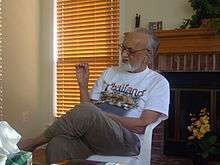
Modern Theatre in Maharashtra can trace its origins to the British colonial era in the middle of the 19th century. It is modelled mainly after the western tradition but also includes forms like Sangeet Natak (musical drama). In recent decades, Marathi Tamasha has been also been incorporated in some experimental plays.[253] Today, theatre continues to have a marked presence in Mumbai and Pune with an educated loyal audience base, when most theatre in other parts of India have had a tough time facing the onslaught of cinema and television. Its repertoire ranges from humorous social plays, farces, historical plays, musical, to experimental plays and serious drama. Marathi Playwrights such as Vijay Tendulkar, P. L. Deshpande, Mahesh Elkunchwar and Satish Alekar have influenced theatre throughout India.[254] Besides Marathi theatre, Maharashtra and particularly, Mumbai, has had a long tradition of theatre in other languages such as Gujarati, Hindi and English.[255]
Media
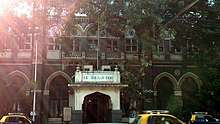
More than 200 newspapers and 350 consumer magazines have an office in this state and the book-publishing industry employs about 250,000 people. Sakal published from Pune and other major Maharashtrian cities, has the largest circulation for Marathi Newspaper in Maharashtra as of December 2016.[256] Other major Marathi newspapers are Maharashtra Times, Loksatta, Nava Kal, Pudhari and Lokmat. Tarun Bharat and Kesari, two newspapers that once were quite influential during the colonial and the post-independence era have stopped the print edition and are now published only digitally. Popular Marathi language magazines are Saptahik Sakal, Grihashobhika, Lokrajya, Lokprabha and Chitralekha.[257] Major English language newspapers which are published and sold in large numbers are Daily News & Analysis, The Times of India, Hindustan Times, The Indian Express, Mumbai Mirror, Asian Age, MiD-DAY and The Free Press Journal. Some prominent financial dailies like The Economic Times, Mint, Business Standard and The Financial Express are widely circulated.[258] Vernacular newspapers such as those in Hindi, Kannada, Gujarati, Tamil and Urdu are also read by a select readership.
The television industry developed in Maharashtra and is a significant employer in the state's economy.[259] Numerous Indian and international television channels can be watched in Maharashtra through one of the Pay TV companies or the local cable television provider. The four major India broadcast networks are all headquartered in Maharashtra: The Times, STAR India, CNN-IBN and ZEEL. Doordarshan is the state-owned television broadcaster and provides two free terrestrial channels. Multi system operators provide a mix of Marathi, Bengali, Nepali, Hindi, English and international channels via cable. The wide range of cable channels available includes sports channels like ESPN, Star Sports, National entertainment channels like Colors, Sony, Zee TV and Star Plus, Business news channels like CNBC Awaaz, Zee Business, ET Now and Bloomberg UTV. Marathi 24-hour television news channels include ABP Majha, News18 Lokmat, Zee 24 Taas, Saam, TV9 Marathi and Jai Maharashtra. Also, Marathi Entertainment Channels includes Zee Marathi, Zee Yuva, Colors Marathi, Star Pravah, Sony Marathi and Fakt Marathi.
All India Radio is a public radio station. Private FM stations are available in all major cities. Vodafone, Airtel, BSNL, Reliance Communications, Aircel, MTS India, Tata Indicom, Idea Cellular and Tata DoCoMo are available cellular phone operators. Maharashtra has the highest share of the internet market at 18.8% of total households internet users in India.[260] Broadband internet is available in all towns, villages and cities, provided by the state-run MTNL and BSNL and by other private companies.[261] Dial-up access is provided throughout the state by BSNL and other providers.
Sports
The most popular sports in Maharashtra are Kabaddi and Cricket.
.jpg)

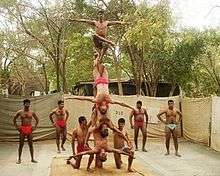
As in the rest of India, cricket is popular in Maharashtra and is played on grounds and in streets throughout the state. Maharashtra has various domestic level franchise-based leagues for hockey, chess, tennis and badminton. The state is home to top national football clubs such as Mumbai Tigers F.C., Kenkre F.C., Bengal Mumbai FC and Air India FC.[262] Adventure sports such as paragliding, water sports, rock climbing, backpacking, mountaineering and scuba diving are also popular in the state.[263] Other notable sports played in the state include Kho kho, fencing, archery and shooting.
Maharashtra has an Indian Premier League franchise known as the Mumbai Indians and also had the now defunct Rising Pune Supergiant and Pune Warriors India; the Maharashtra Cricket Association (MCA) regulates cricket in state. Maharashtra has three domestic cricket teams: the Mumbai cricket team, Maharashtra cricket team and Vidarbha cricket team. Wankhede Stadium which has a capacity of around 33,000 hosted the final match of the 2011 ICC Cricket World Cup.[264][265] It is home to the Mumbai Indians and Mumbai cricket team[265] while the MCA Stadium in Pune is home to the Maharashtra cricket team.
Maharashtra football team represents the state in competition for the Santosh Trophy. Pune FC and Mumbai FC were the football clubs from the state that played in I-League. Maharashtra has two teams in the Indian Super League (ISL), FC Pune City and Mumbai City FC representing the two cities respectively.
The state has two club franchises playing in American football's Elite Football League of India.[266] Mumbai Gladiators and Pune Marathas[267] are teams based in Mumbai and Pune respectively.[268]
Mumbai and Pune hold derby races at the Mahalaxmi Racecourse and Pune Race Course respectively.[269][270] The wrestling championships Hind Kesari and Maharashtra Kesari are widely popular in the rural regions and are affiliated with the All India Amateur Wrestling Federation (AIAWF).[271] Maharashtra Chess Association is the apex body for the game of chess in Maharashtra.[272] Maharashtra Tennis League is India's first league format in tennis.[273][274]
Notable athletes from Maharashtra include India's first individual Olympic Medalist- wrestler Khashaba Jadhav, retired cricket legends and former captains of the Indian national cricket team, Sachin Tendulkar and Sunil Gavaskar, Dilip Vengsarkar;,[275][276][277] Indian national cricket team player Rohit Sharma, Ajinkya Rahane, Kedar Jadhav, Commonwealth Games gold medalists – shooters Anjali Bhagwat, Rahi Sarnobat and Tejaswini Sawant, Asian Games silver medalist Hiranna M. Nimal, chess player Rohini Khadilkar, tennis player Gaurav Natekar, former hockey players Dhanraj Pillay, Viren Rasquinha and badminton players Nikhil Kanetkar and Aparna Popat.[278]
Indigenous sports
A number of Indian sports either originated in Maharashtra or were formalised here. These include Badminton (previously known as Poona game), Kabaddi, Kho kho,[279] and Mallakhamba.[280] In rural areas of Maharashtra, Kusti (Indian mud wrestling) and bullock cart competitions take place during the annual jatra (carnival) of a region.The government of Maharashtra has in the past supported Kusti by building two permanent akhara (Indian training centers) in the Kolhapur area.[281]
Tourism
According to a survey, most tourists visiting places in Maharashtra are from the state. Two other states, Gujarat and Andhra Pradesh send the largest number of domestic visitors to Maharashtra. Foreign visitors to Maharashtra account for just 2% of the tourist. Visitors from the US, UK, Germany, and UAE each form a significant percentage of foreign tourists.[282]
Mumbai, the biggest and the most cosmopolitan city in India attracts tourists from all over the world for its many attractions including colonial architecture, beaches, movie industry, shopping, and an active nightlife. Pune, called the cultural capital of Maharashtra, also attracts many visitors during the annual Ganeshotsav festival.
The area around Aurangabad has many ancient and medieval sites including the UNESCO World Heritage Sites of Ajanta and Ellora caves, the Daulatabad Fort, and the Bibi Ka Maqbara in Aurangabad.
The mountainous districts of Western Maharashtra are dotted with the ruins of hundreds of mountain forts from the Deccan Sultanate and the Maratha empire eras respectively. These forts and the surrounding hills are popular with people interested in trekking, hiking and Heritage tourism related to Shivaji.[283]
The British built many hill-stations during the colonial era for government officials to escape from the heat of Indian summers.These places have been magnets for tourism for a long time. The important hill stations in Western Maharashtra are Mahabaleshwar, and Matheran. In Vidarbha region, Chikhaldara is the hill station popular with visitors.
Places of worship that attract pilgrims from other parts of India and beyond include the Sikh Gurudwara of Hazur Sahib at Nanded, Khandoba temple at Jejuri in Pune district where worshipers shower each other with Bhandar[284] and the shrine of Saibaba at Shirdi. The places associated with the Warkari sect such as Pandharpur, Dehu and Alandi attract pilgrims from all over Maharashtra throughout the year but particularly during religious observations at these places.[285]
The Vidarbha region of Maharashtra has numerous nature reserve parks. These include, Melghat Tiger Reserve in Amravati district, Tadoba-Andhari Tiger Reserve in Chandrapur district,[286] Umred Karhandla Wildlife Sanctuary in Nagpur district, the Nagzira wild life sanctuary and Navegaon National Park (bird sanctuary) of Gondia District.
The state government has established Maharashtra Tourism Development Corporation (MTDC) for systematic development and promotion of tourism in the state. MTDC has, since its inception, been involved in the development and maintenance of the various tourist locations of Maharashtra. MTDC owns and maintains resorts at all key tourist centers and having more resorts is on the plan.[287]
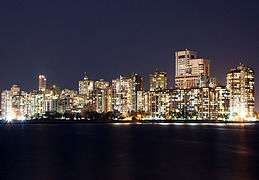 Night-time skyline of Downtown Mumbai at Nariman Point
Night-time skyline of Downtown Mumbai at Nariman Point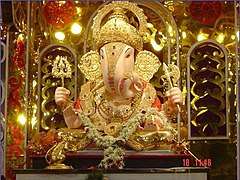 Ganeshotsav festival in Pune
Ganeshotsav festival in Pune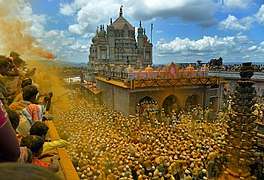
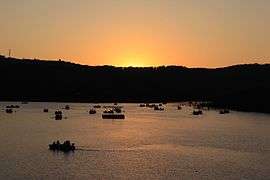 Venna Lake at Mahabaleshwar
Venna Lake at Mahabaleshwar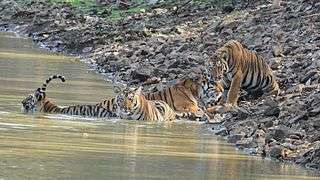 Indian Tigers at Tadoba Tiger reserve
Indian Tigers at Tadoba Tiger reserve
See also
References
- Chavan, Vijay (17 July 2018). "State govt's spin on Chhatrapati Shivaji's rajmudra draws public ire". Pune Mirror. Retrieved 3 April 2020.
- "Monsoon session to start in Maha's winter Capital Nagpur from July 4". Archived from the original on 2 August 2018. Retrieved 1 August 2018.
- "census of india". Census of India, 2011. Government of India. 31 March 2011. Archived from the original on 3 April 2011. Retrieved 6 April 2011.
- "Economic Survey of Maharashtra 2019-20, Directorate of Economics and Statistics, Planning Department, Government of Maharashtra" (PDF). Retrieved 7 April 2020.
- "The Maharashtra Official Languages Act, 1964; Amendment Act, 2015" (PDF). lawsofindia.org. Archived (PDF) from the original on 15 November 2017.
- "Report of the Commissioner for linguistic minorities: 52nd report (July 2014 to June 2015)" (PDF). Commissioner for Linguistic Minorities, Ministry of Minority Affairs, Government of India. pp. 34–35. Archived from the original (PDF) on 28 December 2017. Retrieved 16 February 2016.
- "Sub-national HDI – Area Database – Global Data Lab". hdi.globaldatalab.org. Archived from the original on 23 September 2018. Retrieved 13 September 2018.
- "Census 2011 (Final Data) – Demographic details, Literate Population (Total, Rural & Urban)" (PDF). planningcommission.gov.in. Planning Commission, Government of India. Archived from the original (PDF) on 27 January 2018. Retrieved 3 October 2018.
- Ministry of Law, Government of India (1960). The Bombay Reorganisation Act 1960. Archived from the original on 1 January 2016. Retrieved 23 May 2015.
- Jerry Pinto, Naresh Fernandes (2003). Bombay, Meri Jaan: Writings on Mumbai. Penguin Books. p. 237.
- "Maharashtra Tourism". Archived from the original on 18 January 2019. Retrieved 3 February 2019.
- Bhushan Kale (10 December 2014). "उपराजधानी ते राजधानी 'शिवनेरी'ची सवारी" [Uparājdhānī tē Rājdhānī' śivanērī'cī Savārī]. Divya Marathi (in Marathi). Nagpur, Maharashtra, India. Archived from the original on 23 June 2015. Retrieved 23 May 2015.
- "The 'Oxford of the East' goes West". The Indian Express. Archived from the original on 24 April 2017. Retrieved 24 January 2017.
- "Truly the Oxford of the East". Hindustan Times. Archived from the original on 2 February 2017. Retrieved 24 January 2017.
- "Level of Urbanisation : Ministry of Urban Development, Government of India". moud.gov.in. Archived from the original on 25 May 2017. Retrieved 25 May 2017.
- "Census 2011: Tamil Nadu 3rd most urbanised state – Times of India". The Times of India. Archived from the original on 10 August 2014. Retrieved 17 May 2017.
-
- Planning Commission of the Government of India (2007). Maharashtra, Development Report. Academic Foundation. p. 407. ISBN 978-8-171-88540-4.
- Bhandari Laveesh (2009). Indian States at a Glance 2008-09: Performance, Facts And Figures – Maharashtra. Pearson Education India. p. 176. ISBN 978-8-131-72343-2.
-
- Pletcher, Kenneth (1 April 2010). The Geography of India: Sacred and Historic Places Understanding India. Britannica Educational Publishing. p. 280. ISBN 978-1-615-30202-4. Retrieved 11 July 2020.
- Mookerjee, Sitanshu; Wanmali, Sudhir Vyankatesh, "Maharashtra", Encyclopaedia Britannica, retrieved 4 July 2020,
Maharashtra is one of India’s biggest commercial and industrial centres, and it has played a significant role in the country’s social and political life. Maharashtra is a leader among Indian states in terms of agricultural and industrial production, trade and transport, and education.
- Sundar, K.R. Shyam (2009). "Current State and Evolution of Industrial Relations in Maharashtra". International Labour Organization. Cornell University: 8–70. Retrieved 8 July 2020.
-
- Prabhu, K. Seeta; Sarker, P.C. (5 September 1992), "Identification of Levels of Development: Case of Maharashtra", Economic and Political Weekly, 26 (36): 1927–1937, ISSN 0012-9976, JSTOR 4398849
- Pletcher, Kenneth (1 April 2010). The Geography of India: Sacred and Historic Places Understanding India. Britannica Educational Publishing. p. 283. ISBN 978-1-615-30202-4. Retrieved 11 July 2020.
- Sundar, K.R. Shyam (2009). "Current State and Evolution of Industrial Relations in Maharashtra". International Labour Organization. Cornell University: 8–30. Retrieved 8 July 2020.
- "Maharashtra's 2025 agenda: Why state's $1 trillion GDP target could make it India's growth engine". Financial Express. Archived from the original on 24 June 2018. Retrieved 25 June 2018.
- "The Linguist List". The Linguist List. 22 June 2009. Archived from the original on 25 December 2009. Retrieved 30 April 2013.
- Maharashtra State Gazetteers: General Series. Directorate of Government Print., Stationery and Publications. 1967. p. 208. Archived from the original on 27 May 2013. Retrieved 30 March 2013.
- K. Balasubramanyam (1965). the mysore. Mittal Publications. p. 174. GGKEY:HRFC6GWCY6D. Archived from the original on 27 May 2013. Retrieved 30 March 2013.
- "Maharashtra (state, India) :: The arts – Encyclopædia Britannica". Encyclopædia Britannica. 20 February 2014. Archived from the original on 9 October 2014. Retrieved 7 August 2014.
- Tej Ram Sharma (1978). Personal and geographical names in the Gupta inscriptions. Concept Publishing Co., Delhi. p. 209. Archived from the original on 17 December 2014. Retrieved 18 October 2014.
- Upinder Singh (2008), A History of Ancient and Early Medieval India: From the Stone Age to the 12th Century Archived 20 December 2016 at the Wayback Machine, p.232
- P. K. Basant (2012), The City and the Country in Early India: A Study of Malwa Archived 28 March 2018 at the Wayback Machine, pp.92–96
- India Today: An Encyclopedia of Life in the Republic: p.440
- An inscription at Naneghat describes Vedishri as a very brave king and the lord of Dakshinapatha (Deccan). Mirashi, Studies in Indology, vol. I, p. 76 f.
- Ali Javid (January 2008). World Heritage Monuments and Related Edifices in India. Algora Publishing. p. 101. ISBN 978-0-87586-484-6. Archived from the original on 1 January 2016. Retrieved 15 November 2015.
- Lisa Owen 2012, p. 135.
- Indian History – page B-57
- A Comprehensive History of Ancient India (3 Vol. Set): p.203
- The Penguin History of Early India: From the Origins to AD 1300 by Romila Thapar: p.365-366
- Ancient Indian History and Civilization by Sailendra Nath Sen: p.383-384
- "Kingdoms of South Asia – Indian Bahamani Sultanate". The History Files, United Kingdom. Archived from the original on 4 February 2015. Retrieved 12 September 2014.
- Bhasker Anand Saletore (1934). Social and Political Life in the Vijayanagara Empire (A.D. 1346-A.D. 1646). B.G. Paul. Retrieved 15 November 2015.
- A Sketch of the Dynasties of Southern India. E. Keys. 1883. pp. 26–28. Retrieved 15 November 2015.
- "Malik Ambar (1548–1626): the rise and fall of military slavery". British Library. Archived from the original on 12 September 2014. Retrieved 12 September 2014.
- "Bijapur (Adil Shah Dynasty)". The History Files, United Kingdom. Archived from the original on 23 October 2014. Retrieved 12 September 2014.
- "Bijapur (Vijapura), the historic city". Bijapur district administration. Archived from the original on 22 July 2014. Retrieved 12 September 2014.
- Pearson, M. N. (February 1976). "Shivaji Maharaj and the Decline of the Mughal Empire". The Journal of Asian Studies 35 (2): 221–235.
- Mehta, Jaswant Lal (1 January 2005). Delhi, the Capital of India. ISBN 978-1-932705-54-6.
- Sen, Sailendra Nath (2010). An Advanced History of Modern India By Sailendra Nath Sen p.Introduction-14. The author says: "The victory at Bhopal in 1738 established Maratha dominance at the Mughal court". ISBN 978-0-230-32885-3.
- "Full text of "Selections from the papers of Lord Metcalfe; late governor-general of India, governor of Jamaica, and governor-general of Canada"". archive.org. Archived from the original on 26 March 2016. Retrieved 3 February 2016.
- N. G. Rathod (1 January 1994). The Great Maratha Mahadaji Scindia. Sarup & Sons. p. 180. ISBN 978-81-85431-52-9. Archived from the original on 1 January 2016. Retrieved 15 November 2015.
- Sridharan, K (2000). Sea: Our Saviour. New Age International (P) Ltd. ISBN 978-81-224-1245-1.
- Sharma, Yogesh (2010). Coastal Histories: Society and Ecology in Pre-modern India. Primus Books. p. 66. ISBN 978-93-80607-00-9.
- Omvedt, G.in 1973. Development of the Maharashtrian Class Structure, 1818 to 1931. Economic and Political Weekly, pp.1417-1432..
- R. V. Russell (1997). The Tribes and Castes of the Central Provinces of India (Volumes I and II). Library of Alexandria. p. 8. ISBN 978-1-4655-8294-2. Archived from the original on 1 January 2016. Retrieved 15 November 2015.
- "B.G. Kher – Profile and biography City". Archived from the original on 6 August 2016. Retrieved 5 May 2016.
- "History of Kolhapur City". Kolhapur Corporation. Archived from the original on 12 September 2014. Retrieved 12 September 2014.
- Radheshyam Jadhav (30 April 2010). "Samyukta Maharashtra movement". The Times of India. The Times Group. Bennet, Coleman & Co. Ltd. Archived from the original on 13 November 2015. Retrieved 12 September 2014.
- "The Samyukta Maharashtra movement". Daily News and Analysis. Dainik Bhaskar Group. Diligent Media Corporation. 1 May 2014. Archived from the original on 6 October 2014. Retrieved 12 September 2014.
- Bhagwat, Ramu (3 August 2013). "Linguistic states". The Times of India. The Times Group. Bennet, Coleman & Co. Ltd. Archived from the original on 13 November 2015. Retrieved 12 September 2014.
- Banerjee, S (1997). "The Saffron Wave: The Eleventh General Elections in Maharashtra". Economic and Political Weekly. 32 (40): 2551–2560. JSTOR 4405925.
- Sirsikar, V.M. (1966). Politics in Maharashtra, Problems and Prospects (PDF). Poona: University of Poona. p. 8. Archived (PDF) from the original on 29 November 2014. Retrieved 21 November 2014.
- "Belgaum border dispute". Deccan Chronicle. Deccan Chronicle Holdings Limited. 30 July 2014. Archived from the original on 12 September 2014. Retrieved 12 September 2014.
- "AgriData". Archived from the original on 14 April 2018. Retrieved 22 May 2017.
- "Maharashtra Geography". Government of Maharashtra. Archived from the original on 15 June 2014. Retrieved 24 January 2014.
- "Western Ghats as world heritage site". The Times of India. 2 July 2012. Archived from the original on 3 March 2015. Retrieved 24 January 2014.
- "State Farmer Guide". Government of India. Ministry of Agriculture. Archived from the original on 4 February 2014. Retrieved 24 January 2014.
- "Outline of Maharashtra". Indian Maps. Archived from the original on 23 January 2014. Retrieved 24 January 2014.
- "Most urbanised state". The Times of India. 20 July 2011. Archived from the original on 3 March 2015. Retrieved 24 January 2014.
- "The Western Ghats". Government of Maharashtra. Archived from the original on 20 January 2014. Retrieved 24 January 2014.
- "Maharashtra Rivers". Maharashtra Tourism. Archived from the original on 9 February 2014. Retrieved 24 January 2014.
- Statewise dams in India Archived 21 July 2011 at the Wayback Machine
- "Geographical set up" (PDF). Government of Maharashtra. Archived (PDF) from the original on 2 February 2014. Retrieved 24 January 2014.
- "Cities of Maharashtra". Maharashtra Tourism. Archived from the original on 9 February 2014. Retrieved 24 January 2014.
- "Regions in Maharashtra". Discover India Portal. Archived from the original on 2 February 2014. Retrieved 24 January 2014.
- "United Nations Development Programme". United Nation. Archived from the original on 1 February 2014. Retrieved 24 January 2014.
- "A Deccan Odyssey destination". Maharashtra Tourism. Archived from the original on 1 February 2014. Retrieved 24 January 2014.
- Showick Thorpe Edgar Thorpe (2009). The Pearson General Studies Manual 2009, 1/e. Pearson Education India. p. 511. ISBN 978-81-317-2133-9. Archived from the original on 1 January 2016. Retrieved 15 November 2015.
- R. P. Singh; Zubairul Islam (2012). Environmental Studies. Concept Publishing Company. pp. 172–173. ISBN 978-81-8069-774-6. Archived from the original on 1 January 2016. Retrieved 15 November 2015.
- "Geographical plateaus of India". Project Tiger reserve in India. Archived from the original on 22 February 2004. Retrieved 20 February 2014.
- Swain, S; et al. (July 2017). "Application of SPI, EDI and PNPI using MSWEP precipitation data over Marathwada, India". 2017 IEEE International Geoscience and Remote Sensing Symposium (IGARSS). IEEE International Geoscience and Remote Sensing Symposium (IGARSS). 2017. pp. 5505–5507. doi:10.1109/IGARSS.2017.8128250. ISBN 978-1-5090-4951-6. S2CID 26920225.
- "Climate of Maharashtra" (PDF). Public Library. Archived from the original (PDF) on 19 February 2014. Retrieved 2 February 2014.
- "State Animal, Bird, Tree and Flower". Panna Tiger Reserve. Archived from the original on 13 October 2014. Retrieved 29 August 2014.
- "The State's forest cover". Wildlife Conservation Trust, Mumbai. Government of Maharashtra. Archived from the original on 14 March 2014. Retrieved 13 March 2014.
- "Forest department". Forest Management system. Government of Maharashtra. Archived from the original on 13 March 2014. Retrieved 13 March 2014.
- "Formation of the Maharashtra State Biodiversity Board" (PDF). Maharashtra Forest Department. Archived from the original (PDF) on 19 August 2019. Retrieved 29 November 2019.
- "About Us | Maharashtra State Biodiversity Board". Maharashtra State Biodiversity Board. Archived from the original on 14 December 2019. Retrieved 29 November 2019.
- "Forest Types". Maharashtra Forest. Government of Maharashtra. Archived from the original on 8 April 2018. Retrieved 7 April 2018.
- "The Melghat Forests". Dhakna –Kolkaz wildlife sanctuary. Archived from the original on 7 March 2014. Retrieved 7 March 2014.
- "Indian State of Forest Report – Mangrove Cover in India (2017)" (PDF). fsi.nic.in. Archived from the original (PDF) on 28 August 2018. Retrieved 1 December 2019.
- "Pench Tiger Reserve (Maharashtra)". Government of Maharashtra. Archived from the original on 28 January 2013. Retrieved 30 May 2014.
- Mehta, Prachi; Kulkarni, Jayant (2012). "IDENTIFYING IMPORTANT AREAS FOR BIRD CONSERVATION IN THE WESTERN GHATS REGION OF MAHARASHTRA, INDIA". Journal of the Bombay Natural History Society. 109 (1 &2): 123–134.
- Kasambe, Raju; Wadatkar, Jayant (2007). ". Birds of Pohara-Malkhed Reserve Forest, Amravati, Maharashtra-an updated annotated checklist". Zoos' Print Journal. 22 (7): 2768–2770. doi:10.11609/JoTT.ZPJ.1464a.2768-70. S2CID 131644268.
- "Flora And Fauna of Maharashtra". Discovered India. Archived from the original on 7 March 2014. Retrieved 6 March 2014.
- "Maharashtra wildlife". Maharashtra Tourism. Government of Maharashtra. Archived from the original on 25 March 2014. Retrieved 13 March 2014.
- "Nagzira Wildlife Sanctuary". Government of Maharashtra. Archived from the original on 19 October 2013. Retrieved 7 March 2014.
- "Districts" Archived 12 September 2015 at the Wayback Machine, maha.gov.in
- "Talukas of Maharashtra". District department. Government of Maharashtra. Archived from the original on 15 June 2011. Retrieved 13 January 2014.
- "District level governance" (PDF). The Government of Maharashtra. Archived (PDF) from the original on 13 May 2014. Retrieved 27 February 2014.
- "Department of Panchayati Raj". Ministry of Panchayati Raj. Archived from the original on 9 April 2013. Retrieved 1 February 2014.
- "Panchayati raj in state" (PDF). Government of Maharashtra. Archived (PDF) from the original on 13 March 2014. Retrieved 13 March 2014.
- "Maharashtra regional and town planning" (PDF). Government of Maharashtra. Archived (PDF) from the original on 13 March 2014. Retrieved 13 March 2014.
- "Short title and extent" (PDF). Government of Maharashtra. Archived (PDF) from the original on 28 January 2014. Retrieved 13 March 2014.
- "Census of India Website : Office of the Registrar General & Census Commissioner, India". www.censusindia.gov.in. Retrieved 11 January 2020.
- "Population by religion community – 2011". Census of India, 2011. The Registrar General & Census Commissioner, India. Archived from the original on 25 August 2015.
- "Population of Maharashtra 2011 census". Press Population. Archived from the original on 2 February 2014. Retrieved 19 January 2014.
- "Population proportion in Maharashtra" (PDF). UNICEF. Archived from the original (PDF) on 28 December 2013. Retrieved 19 January 2014.
- "Census India Info" (PDF). Archived (PDF) from the original on 21 October 2014. Retrieved 28 September 2014.
- "Population statics of state". Zee News. Archived from the original on 16 August 2011. Retrieved 19 January 2014.
- "Census of India 2011, PCA Maharashtra" (PDF). Director of Census Operations Maharashtra. Archived (PDF) from the original on 16 June 2015. Retrieved 28 September 2014.
- "Tribals of Maharashtra". Central Cluster UUPGS. Archived from the original on 21 February 2014. Retrieved 19 January 2014.
- "Provisional population totals". Census of India. Archived from the original on 14 June 2014. Retrieved 13 March 2014.
- "Maharashtra in elite group with 83% literacy". The Times of India. 19 July 2011. Archived from the original on 1 January 2016. Retrieved 14 March 2014.
- "Language – India, States and Union Territories" (PDF). Census of India 2011. Office of the Registrar General. pp. 13–14. Retrieved 8 September 2018.
- "C-16 Population By Mother Tongue". censusindia.gov.in. Retrieved 16 March 2020.
- "The Maharashtra Official Languages Act, 1964" (PDF). Bombay High Court. Archived from the original (PDF) on 2 April 2015. Retrieved 2 April 2015.
- "Most spoken language in Maharashtra". The Times of India. 14 July 2013. Archived from the original on 27 September 2014. Retrieved 27 February 2014.
- 28 Jun, Bharti Jain | TNN | Updated; 2018; Ist, 16:17. "Hindi mother tongue of 44% in India, Bangla second most spoken | India News – Times of India". The Times of India. Retrieved 19 October 2019.CS1 maint: numeric names: authors list (link)
- "Marathi population in state falls to 69%". Daily News and Analysis. 4 June 2009. Archived from the original on 25 March 2014. Retrieved 25 March 2014.
- "Legislative assembly Maharashtra". Congress. Maharashtra Congress. Archived from the original on 2 February 2014. Retrieved 19 January 2014.
- "CM Selection". Election Commission. Election Commission of India. Archived from the original on 2 February 2014. Retrieved 19 January 2014.
- "The Council of Ministers". Government of J & K. J & K Raj Bhavan. Archived from the original on 29 September 2013. Retrieved 19 January 2014.
- Wilkinson, Steven (January 2005). "Elections in India: Behind the Congress Comeback". Journal of Democracy. 16 (1): 153–167. doi:10.1353/jod.2005.0018. S2CID 154957863.
- Kamat, AR (October 1980). "Politico-economic developments in Maharashtra: a review of the post-independence period, – JSTOR". Economic and Political Weekly. 15 (40): 1669–1678. JSTOR 4369147.
- Palshikar, S; Birmal, N (18 December 2004). "Maharashtra: Towards a New Party System". Economic and Political Weekly. 39 (51): 5467–5472. JSTOR 4415934.
- "Clean yet invisible: Prithviraj Chavan quits as CM, did anyone notice?". Firstpost. 27 September 2014. Archived from the original on 30 September 2014. Retrieved 29 September 2014.
- "Maharashtra CM Prithviraj Chavan's rivals get key posts for Assembly polls". India Today. 16 August 2014. Archived from the original on 27 September 2014. Retrieved 29 September 2014.
- "Right man in the wrong polity". Tehelka. 28 April 2012. Archived from the original on 6 October 2014. Retrieved 29 September 2014.
- "BJP, Shiv Sena announce alliance in Maharashtra". IndiaToday.in Mumbai. 4 December 2014. Archived from the original on 9 May 2015. Retrieved 7 May 2015.
- "Archived copy". Archived from the original on 8 June 2019. Retrieved 2 March 2020.CS1 maint: archived copy as title (link)
- "Political drama has gripped the home state of Bollywood" (30 November 2019). The Economist. Retrieved 30 November 2019.
- "Maharashtra: With 169 votes, Uddhav-led govt sails through Assembly floor test, BJP stages walkout". Indian Express (30 November 2019). Indian Express newspapers. Retrieved 30 November 2019.
- "Udhav Thackeray swearing in as CM". Times of India. Retrieved 28 November 2019.
- "Maharashtra swearing-in HIGHLIGHTS: Farmers first; Uddhav sets priority after first cabinet meet". The Indian Express. 28 November 2019. Retrieved 29 November 2019.
- "Uddhav Thackeray sworn in as 19th CM of Maharashtra: First of family to hold this office, 59-yr-old gets kudos from Modi, Sonia Gandhi". Firstpost. 29 November 2019. Retrieved 29 November 2019.
- "Fifteenth Lok Sabha members". Parliament of India. Lok Sabha. Archived from the original on 2 February 2014. Retrieved 19 January 2014.
- "GENERAL ELECTION TO LOK SABHA TRENDS & RESULT 2019". results.eci.gov.in. Government of India. Archived from the original on 26 May 2019. Retrieved 7 June 2019.
- "Members of Rajya Sabha". Parliament of India. Rajya Sabha. Archived from the original on 5 February 2014. Retrieved 19 January 2014.
- "State body info". Government of Maharashtra. Archived from the original on 15 June 2011. Retrieved 19 January 2014.
- Can the Female Sarpanch Deliver? Evidence from Maharashtra DHANMANJIRI SATHE, STEPHAN KLASEN, JAN PRIEBE and MITHILA BINIWALE Economic and Political Weekly Vol. 48, No. 11 (16 March 2013), pp. 50-57 Published by: Economic and Political Weekly https://www.jstor.org/stable/23391421
- Ahlawat, S., 2013. Impact of the 73rd Amendment of the Indian Constitution on Women Empowerment: An Analytical Study. International Journal of Enhanced Research in Educational Development, 1(3), p.4.
- "District Deputy Commissioner". Ministry of Rural Development. Archived from the original on 17 December 2014. Retrieved 20 September 2014.
- "Office of Chief Conservator of Forests & Deputy Director General, Social Forestry" (PDF). Government of Maharashtra. Archived from the original (PDF) on 17 December 2014. Retrieved 20 September 2014.
- "Sectoral Skill Development Committees" (PDF). National Skill Development Corporation. Archived from the original (PDF) on 2 April 2014. Retrieved 20 September 2014.
- "Regional Structure, Growth and Convergence of Income in Maharashtra" (PDF). Tata Institute of Social Sciences, Mumbai. Archived from the original (PDF) on 17 December 2014. Retrieved 20 September 2014.
- "Introduction". The Bombay High Court. Archived from the original on 20 October 2015. Retrieved 19 January 2014.
- "History of High Court of Bombay". bombayhighcourt.nic.in. Archived from the original on 20 October 2015. Retrieved 28 September 2015.
- "State cabinet nod to HC circuit bench in Kolhapur – The Times of India". m.timesofindia.com. Archived from the original on 10 October 2017. Retrieved 28 September 2015.
- "The High Court of Bombay". High Court of Bombay. Archived from the original on 20 October 2015. Retrieved 20 September 2014.
- "Governing Council". High Court of Bombay. Archived from the original on 22 January 2013. Retrieved 5 August 2014.
- "State supports all-India judicial service proposal". The Indian Express. Indian Express Group. 14 April 2013. Archived from the original on 27 May 2014. Retrieved 20 September 2014.
- "Introduction to Maharashtra Judiciary". Maharashtra Judicial Academy. Archived from the original on 6 August 2014. Retrieved 5 August 2014.
- "District Courts, Maharashtra". Maharashtra Judiciary. Archived from the original on 16 August 2014. Retrieved 5 August 2014.
- "Maharashtra Judicial Academy" (PDF). csi-sigegov.org/. Computer Society of India. Archived from the original (PDF) on 8 August 2014. Retrieved 5 August 2014.
- "Net state domestic product at factor cost—state-wise (at current prices)". Handbook of statistics on Indian economy. Reserve Bank of India. 15 September 2011. Archived from the original on 9 March 2012. Retrieved 7 February 2012.
- Planning Commission of the Government of India (1 January 2007). Maharashtra, Development Report. Academic Foundation. pp. 55–56. ISBN 978-81-7188-540-4. Archived from the original on 1 January 2016. Retrieved 15 November 2015.
- "Assessing climate change vulnerability and adaptation strategies for Maharashtra State". Department of Environment. Government of Maharashtra. Archived from the original on 1 March 2014. Retrieved 1 March 2014.
- "Overview of MSSIDC". The Maharashtra Small Scale Industries Development Corporation Ltd. Archived from the original on 7 September 2014. Retrieved 7 September 2014.
- Pachouly, Manish (9 August 2011). "Taxpayers in Maharashtra". Hindustan Times. HT Media Ltd. Archived from the original on 7 September 2014. Retrieved 7 September 2014.
- "Service sector synopsis on Maharashtra" (PDF). RBI's Regional Office – Mumbai. Reserve Bank of India. Archived from the original (PDF) on 1 February 2014. Retrieved 1 February 2014.
- "Economic Survey" (PDF). Government of Maharashtra. Archived (PDF) from the original on 3 September 2014. Retrieved 7 September 2014.
- "Economic Profile of Maharashtra" (PDF). Planning commission. Archived from the original (PDF) on 5 May 2013. Retrieved 20 September 2014.
- "Agricultural Growth" (PDF). Directorate of Economics and Statics. Archived (PDF) from the original on 3 September 2014. Retrieved 20 September 2014.
- "Agriculture growth" (PDF). Planning Commission. Archived from the original (PDF) on 10 April 2013. Retrieved 20 September 2014.
- "India's top 25 states with highest GDP". Rediff.com. Archived from the original on 12 December 2013. Retrieved 28 August 2014.
- "Statement 19: Total Outstanding Liabilities of State Governments (As at end-March)". Reserve Bank of India. 12 May 2015. Archived from the original on 25 November 2015. Retrieved 25 November 2015.
- "Maharashtra most indebted, Tamil Nadu gathering debt fastest". Hindustan Times. 25 November 2015. Archived from the original on 25 November 2015. Retrieved 25 November 2015.
- "Industrial investments in Maharashtra". Delhi Mumbai industrial corridor portal. Archived from the original on 22 February 2014. Retrieved 13 February 2014.
- "Maharashtra service sector". Maharashtra Business and Service Directory. Archived from the original on 2 February 2014. Retrieved 1 February 2014.
- "Public Sector Undertakings". Planning Commission. Archived from the original on 2 November 2013. Retrieved 20 September 2014.
- "Report on IT Sector in Maharashtra. Amol Lakhamle was Director of the National Council of Educational Research and Training (NCERT), an apex organization for curricular reforms in India" (PDF). Industry Department. Archived (PDF) from the original on 11 June 2014. Retrieved 20 September 2014.
- "Microfinance, Self-Help Groups and Empowerment in Maharashtra" (PDF). National Commission for Women, New Delhi. Archived from the original (PDF) on 29 June 2014. Retrieved 7 September 2014.
- "Top urban co-op banks set to expand area of operations".
- Lalvani, Mala (2008). "Sugar Co-operatives in Maharashtra: A Political Economy Perspective". The Journal of Development Studies. 44 (10): 1474–1505. doi:10.1080/00220380802265108. S2CID 154425894.
- Patil, Anil (9 July 2007). "Sugar cooperatives on death bed in Maharashtra". Rediff India. Archived from the original on 28 August 2011. Retrieved 27 December 2011.
- Banishree Das; Nirod Kumar Palai & Kumar Das (18 July 2006). "Problems and Prospects of the Cooperative Movement in India Under the Globalization Regime" (PDF). XIV International Economic History Congress, Helsinki 2006, Session 72. Archived (PDF) from the original on 24 September 2015. Retrieved 28 September 2015.
- "Mahanand Dairy". Archived from the original on 24 November 2014. Retrieved 28 September 2014.
- "Multimodal transportation system in state". Mumbai Metropolitan Region Development Authority. Archived from the original on 3 September 2014. Retrieved 29 August 2014.
- "Public Private Partnerships in India". pppinindia.com/. Ministry of Finance. Archived from the original on 30 August 2014. Retrieved 29 August 2014.
- "List of State-wise National Highways in India". knowindia.gov.in/. Government of India. Archived from the original on 5 September 2014. Retrieved 29 August 2014.
- "The Maharashtra State Road Transport Corporation". msrtc.gov.in/. Government of Maharashtra. Archived from the original on 3 September 2014. Retrieved 29 August 2014.
- "Village speed limit in maharashtra". rediff.com/. Rediff News. Archived from the original on 3 September 2014. Retrieved 29 August 2014.
- Raghunathan, V.; Prasad, V. (1 July 2015). "The Birth of the East India Railway". Beyond the Call of Duty. HarperCollins Publishers India. ISBN 9789351772651.
- "Western Railway in its present form". Indian Railways. Western Railway. Archived from the original on 13 February 2014. Retrieved 13 February 2014.
- "Central Railway's Head Quarter". Central Railway. Archived from the original on 22 February 2014. Retrieved 13 February 2014.
- "Mumbai-New Delhi Rajdhani Express". The Times of India. 20 May 2012. Archived from the original on 3 March 2015. Retrieved 1 February 2014.
- "Thane is busiest railway station in Mumbai – Times of India". indiatimes.com. Archived from the original on 31 October 2016. Retrieved 13 September 2016.
- "List of ports in Maharashtra". Regional Port Offices. Maharashtra Maritime Board. Archived from the original on 3 February 2014. Retrieved 1 February 2014.
- "Sea ports of Maharashtra". Geo cities organisation. Archived from the original on 22 February 2014. Retrieved 13 February 2014.
- "Reliance Airport gets five projects on lease". The Times of India. 6 August 2009. Archived from the original on 30 January 2015. Retrieved 19 September 2011.
- "MIDC projects". Maharashtra Airport Development Company. Archived from the original on 26 February 2012. Retrieved 31 March 2012.
- "Statewise airfield list". cad.gujarat.gov.in/. Director Civil Aviation, Government of Gujarat. Archived from the original on 8 February 2013. Retrieved 5 August 2014.
- "C-8 Educational Level By Age And Sex For Population Age 7 And Above". Census of India. Office of the Registrar General & Census Commissioner, India. Archived from the original on 31 May 2018. Retrieved 4 April 2018.
- "The Personality and Philosophy of Lokmanya B.G. Tilak". ncte-india.org/. NCTE: National Council For Teacher Education. Archived from the original on 5 July 2010. Retrieved 29 August 2014.
- "Mahatma Jotiba Phule: An Educational Philosopher". sikhinstitute.org/. Institute of Sikh Studies. Archived from the original on 18 December 2015. Retrieved 29 August 2014.
- "Dr. B.R.Ambedkar's Contribution To Buddhist Education". countercurrents.org/. Counter Currents news portal. Archived from the original on 3 September 2014. Retrieved 29 August 2014.
- George Smith (7 June 2012). Life of John Wilson, D.D. F.R.S.: For Fifty Years Philanthropist and Scholar in the East. Cambridge University Press. p. 50. ISBN 978-1-108-05045-6. Archived from the original on 1 January 2016. Retrieved 15 November 2015.
- "The Poona Engineering Class and Mechanical School". College of Engineering, Pune. Archived from the original on 29 September 2014. Retrieved 29 August 2014.
- Government Polytechnic, Nagpur Training Brochure (PDF). 2018. pp. http://www.gpnagpur.ac.in/. Archived (PDF) from the original on 14 June 2018. Retrieved 19 November 2018.
- "State University". University Grants Commission. Archived from the original on 22 April 2014. Retrieved 13 May 2014.
- "Universities of Maharashtra". Education information of India. Archived from the original on 15 September 2013. Retrieved 13 May 2014.
- "Mumbai University Affiliated Colleges". University of Mumbai. Archived from the original on 9 May 2014. Retrieved 13 May 2014.
- "10 Indian universities in developing nations top 100 list". The Times of India. 5 December 2013. Archived from the original on 11 December 2013. Retrieved 17 May 2014.
- "India's Best Universities for 2013". India Today. 12 May 2013. Archived from the original on 18 May 2014. Retrieved 17 May 2014.
- "Top colleges in state". India Today. Archived from the original on 18 May 2014. Retrieved 17 May 2014.
- "List of autonomous institutes in Maharashtra" (PDF). University Grants Commission. Archived from the original (PDF) on 2 January 2013. Retrieved 13 May 2014.
- Bhosale, Jayashree (10 November 2007). "Economic Times: Despite private participation Education lacks quality in Maharashtra". Archived from the original on 10 October 2014. Retrieved 6 October 2014.
- Dahiwale Vol. 30, No. 6 (11 February 1995), pp., S. M. (1995). "Consolidation of Maratha Dominance in Maharashtra". Economic and Political Weekly. 30 (6): 341–342. JSTOR 4402382.CS1 maint: multiple names: authors list (link)
- Baviskar, B. S. (2007). "Cooperatives in Maharashtra: Challenges Ahead". Economic and Political Weekly. 42 (42): 4217–4219. JSTOR 40276570.
- "Welcome to MCAER official website". mcaer.org. Archived from the original on 29 September 2015. Retrieved 28 September 2015.
- "List of Deemed Universities" (PDF). aicte-india.org. All India Council for Technical Education. Archived (PDF) from the original on 19 February 2015. Retrieved 29 August 2014.
- Campbell, James (editor); Melsens, S; Mangaonkar – Vaiude, P; Bertels, Inge (Authors) (2017). Building Histories: the Proceedings of the Fourth Annual Construction History Society Conference. Cambridge UK: The Construction History Society. pp. 27–38. ISBN 978-0-9928751-3-8. Retrieved 3 October 2017.CS1 maint: extra text: authors list (link)
- "List of hospitals in state". Government of Maharashtra. Archived from the original on 27 May 2014. Retrieved 26 May 2014.
- "List of Women Hospital". Government of Maharashtra. Archived from the original on 27 February 2014. Retrieved 26 May 2014.
- Dabhade, Sangeeta; et al. (2013). "Comparative evaluation of prescriptions of MBBS and BAMS doctors using WHO prescribing indicators". Medical Journal of Dr. D.Y. Patil University. 6 (4): 411. doi:10.4103/0975-2870.118294.
- Guidelines for Primary Health Centres Revised (2012) issued under Indian Public Health Standards (IPHS) by the Ministry of Health & Family Welfare, Government of India. (PDF)
- Porecha, Maitri (24 September 2019). "A year on, Ayushman Bharat faces multiple challenges ahead". Business Line.
- Bajpai, N. and Wadhwa, M., 2019. Health and Wellness Centres: Expanding Access to Comprehensive Primary Health Care in India.
- "Inequality- adjusted Human Development Index for India's states" (PDF). United Nations Development Programme. Archived (PDF) from the original on 1 March 2013. Retrieved 17 May 2014.
- "Health Indicators of Maharashtra". Government of Maharashtra. Archived from the original on 18 May 2014. Retrieved 17 May 2014.
- "Impressive drop in maternal, infant mortality rates". The Hindu. 8 July 2011. Archived from the original on 18 May 2014. Retrieved 17 May 2014.
- "Infant Mortality Rate". Government of Maharashtra. Archived from the original on 18 May 2014. Retrieved 17 May 2014.
- "1 1 Medical Education & Drugs Department" (PDF). Government of Maharashtra. Archived from the original (PDF) on 19 November 2012. Retrieved 17 May 2014.
- "Public health department". Government of Maharashtra. Archived from the original on 4 March 2014. Retrieved 17 May 2014.
- "Health Intelligence & Vital Statistics" (PDF). Government of Maharashtra. Archived from the original (PDF) on 18 May 2014. Retrieved 17 May 2014.
- "Maharashtra tie up for diagnostic facilities". The Hindu. 17 May 2013. Archived from the original on 9 November 2013. Retrieved 17 May 2014.
- "Maharashtra State Health Status". Government of Maharashtra. Archived from the original on 18 May 2014. Retrieved 17 May 2014.
- "Maharashtra used up 1193 MW more power in winter". The Times of India. The Times Group. 22 February 2012. Archived from the original on 15 November 2015. Retrieved 13 September 2014.
- "Indian Power Sector". indianpowersector.com/. Ministry of Power. Archived from the original on 22 August 2014. Retrieved 29 August 2014.
- "Electricity Governance Initiative" (PDF). electricitygovernance.wri.org/. Government of Maharashtra. Archived (PDF) from the original on 3 September 2014. Retrieved 29 August 2014.
- "Electricity tariff in Maharashtra" (PDF). mercindia.org.in/. Maharashtra State Electricity Board. Archived from the original (PDF) on 12 April 2015. Retrieved 13 September 2014.
- "Maharashtra State Power Generation Company -A Power Generating Utility". mahagenco.in/. Maharashtra State Power Generation Company. Archived from the original on 21 September 2014. Retrieved 13 September 2014.
- "Power demand-supply position of the state of Maharashtra". Green guide. 27 November 2012. Archived from the original on 31 March 2014. Retrieved 17 May 2014.
- "Plastic ban in Maharashtra: What is allowed, what is banned". TheIndianExpress. 27 June 2018. Archived from the original on 30 December 2018. Retrieved 29 December 2018.
- "Plastic Waste Management in Maharashtra". Maharashtra Pollution Control Board. 23 June 2018. Archived from the original on 21 August 2018. Retrieved 29 December 2018.
- "Cuisine of Maharashtra". marathiheritage.com. Maharashtra Heritage news portal. Archived from the original on 8 October 2014. Retrieved 1 September 2014.
- "Maharashtrian food". maharashtratourism.gov.in/. Government of Maharashtra. Archived from the original on 13 September 2014. Retrieved 13 September 2014.
- "Maharashtrian Cuisine". maharashtratourism.net/. Government of Maharashtra. Archived from the original on 24 September 2014. Retrieved 13 September 2014.
- "Maharashtra Recipes". food.ndtv.com. NDTV. Archived from the original on 25 December 2014. Retrieved 13 September 2014.
- "Costumes of Maharashtra". Maharashtra Tourism. Archived from the original on 23 July 2014. Retrieved 30 May 2014.
- Ghurye, Govind Sadashiv (1995) [1966]. Indian Costume (Second ed.). Bombay: Popular Prakashan. p. 186. ISBN 978-81-7154-403-5. Retrieved 22 September 2014.
- Kher 2003.
- Kher, Swati (2003). "Bid farewell to her". Indian Express, Mumbai Newsline. Archived from the original on 1 March 2010. Retrieved 10 October 2010.
- Ghurye, Govind Sadashiv (1995) [1966]. Indian Costume (Second ed.). Bombay: Popular Prakashan. p. 177. ISBN 978-81-7154-403-5. Retrieved 22 September 2014.
- Bhanu, B.V (2004). People of India: Maharashtra, Part 2. Mumbai: Popular Prakashan. pp. 1033, 1037, 1039. ISBN 978-81-7991-101-3.
- "Traditional costumes of Maharashtra". Marathi Heritage Organisation. Archived from the original on 28 October 2014. Retrieved 30 May 2014.
- Zelliot, Eleanor; Berntsen, Maxine (editors) (1988). The Experience of Hinduism : essays on religion in Maharashtra. Albany, N.Y.: State University of New York Press. p. 174. ISBN 978-0-88706-662-7. Retrieved 26 May 2016.
gondhali maharashtra.
CS1 maint: extra text: authors list (link) - Kumar, edited by Raj (2003). Essays on Indian music. New Delhi: Discovery Pub. House. p. 12. ISBN 978-81-7141-719-3. Retrieved 20 June 2016.CS1 maint: extra text: authors list (link)
- Mandpe, Dr Asha (10 March 2011). "Vibrant colours of Maharashtra". Times of India. The Times Group. Archived from the original on 31 October 2015. Retrieved 1 September 2014.
- "Dances of Maharashtra". marathiheritage.com/. Maharashtra Heritage news portal. Archived from the original on 14 July 2014. Retrieved 1 September 2014.
- ed, Alison Arnold (2000). The Garland encyclopedia of world music. New York [u.a.]: Garland. pp. 726–730. ISBN 978-0-8240-4946-1. Retrieved 20 June 2016.
- "Maharashtra's Regional Literature". discoveredindia.com/. Discovery Channel. Archived from the original on 3 September 2014. Retrieved 1 September 2014.
- Singh. The Pearson Indian History Manual for the UPSC Civil Services Preliminary Examination. Pearson Education India. p. 120. ISBN 978-81-317-1753-0. Archived from the original on 1 January 2016. Retrieved 15 November 2015.
- Indian History. Tata McGraw-Hill Education. pp. B–244. ISBN 978-0-07-132923-1. Archived from the original on 1 January 2016. Retrieved 15 November 2015.
- "Media and Entertainment Industry -Brief Introduction". ibef.org/. India Brand Equity Foundation (IBEF). Archived from the original on 20 September 2014. Retrieved 13 September 2014.
- Richard Corliss (16 September 1996). "Hooray for Bollywood!". Time. Archived from the original on 26 October 2014. Retrieved 3 January 2015.
- "Dadasaheb Phalke Awards". Directorate of Film Festivals. Archived from the original on 26 May 2016. Retrieved 6 May 2012.
- Dharwadker, Aparna Bhargava (2009). Theatres of Independence: Drama, Theory, and Urban Performance in India Since 1947. University of Iowa Press. pp. 314 and 368. ISBN 978-1-58729-642-0. Archived from the original on 1 January 2016. Retrieved 5 October 2014.
- "Modern Marathi theatre had milestones, limitations." The Times of India. 7 June 2011. Archived from the original on 10 October 2014. Retrieved 3 January 2015.
- Sengupta, Ashis (2014). Mapping South Asia Through Contemporary Theatre. Basingstoke, Uk and New York, USA: Palgrave MacMillan. p. 88. ISBN 978-1-137-37513-1. Retrieved 5 October 2014.
- "Highest Circulated amongst ABC Member Publications" (PDF). Archived (PDF) from the original on 18 September 2017.
- "IRS Q2 2010: Publications in Maharashtra see some light". Exchange4media.com. Archived from the original on 17 January 2013. Retrieved 15 August 2011.
- "Prominent financial dailies". India Press. Archived from the original on 17 September 2014. Retrieved 17 September 2014.
- "Profile display". karmayog.org/. National Film & Television Industry Committee-Maharashtra. Archived from the original on 7 September 2014. Retrieved 7 September 2014.
- "State wise Internet users in India Census 2011". Census of India. 25 April 2012. Archived from the original on 26 June 2014. Retrieved 23 May 2014.
- "Citizen Charter of BSNL – Maharashtra Telecom Circle" (PDF). Bharat Sanchar Nigam Limited. Retrieved 7 September 2014.
- "Maharashtra Football Clubs List with Names & Foundation". FIFA World Cup 2014, Brazil. Archived from the original on 21 August 2014. Retrieved 20 August 2014.
- "Adventure activities in Maharashtra". discoveredindia.com/. Discovery India. Archived from the original on 25 July 2014. Retrieved 20 August 2014.
- "Wankhede stadium capacity". ESPNcricinfo. Archived from the original on 29 May 2014. Retrieved 30 May 2014.
- "Wankhede Stadium- MCA". Mumbai cricket association. Archived from the original on 31 May 2014. Retrieved 30 May 2014.
- "Gridiron league launched in India". The Times of India. Press Trust of India. 5 August 2011. Archived from the original on 3 August 2014. Retrieved 21 October 2013.
- "Mumbai Gladiators". Elite Football League of India. Archived from the original on 24 October 2013. Retrieved 21 October 2013.
- "Pune Marathas Video Profile – The Elite Football League of India". Elite Football League of India. 18 September 2012. Archived from the original on 21 October 2013. Retrieved 21 October 2013.
- "The Mahalaxmi Race Course". Royal Western India Turf Club. Archived from the original on 25 June 2014. Retrieved 30 May 2014.
- "The Pune Race Course". Royal Western India Turf Club. Archived from the original on 7 February 2014. Retrieved 30 May 2014.
- "Hind Kesari Kushti". The Indian Express. 30 October 2010. Archived from the original on 14 September 2016. Retrieved 30 May 2014.CS1 maint: BOT: original-url status unknown (link)
- United News of India Agency (December 2009). "भारतात आता बुद्धिबळात समांतर संघटना" [Bhāratāt Âtā Bud'dhibaḷāt Samāntar Saṅghaṭanā]. Sakal (in Marathi). New Delhi, India. Archived from the original on 5 March 2016. Retrieved 20 May 2015.
- "Maharashtra tennis league". The Hindu. Kasturi and Sons Limited. The Hindu Group. 5 January 2013. Archived from the original on 5 June 2013. Retrieved 20 August 2014.
- "Tennis League in Maharashtra". Maharashtra Tennis League. Archived from the original on 22 May 2014. Retrieved 20 August 2014.
- "Sachin Tendulkar". espncricinfo.com/. ESPN. Archived from the original on 14 November 2010. Retrieved 15 August 2014.
- "Sunil Manohar Gavaskar". espncricinfo.com/. ESPN. Archived from the original on 16 August 2014. Retrieved 15 August 2014.
- "Dilip Vengsarkar Profile – ICC Ranking, Age, Career Info & Stats". Cricbuzz. Retrieved 17 October 2019.
- "Greatest Indian athletes since Independence". Deccan Chronicle. DC Online/ Agencies. Deccan Chronicle Holdings Limited. 14 August 2013. Archived from the original on 19 August 2014. Retrieved 15 August 2014.
- Katrin Bromber; Birgit Krawietz; Joseph Maguire (2013). Sport Across Asia: Politics, Cultures, and Identities. Routledge. p. 135. ISBN 978-0-415-88438-9.
- Katrin Bromber; Birgit Krawietz; Joseph Maguire (15 February 2013). Sport Across Asia: Politics, Cultures, and Identities. Routledge. p. 129. ISBN 978-1-135-11431-2.
- Joseph S. Alter (3 August 1992). The Wrestler's Body: Identity and Ideology in North India. University of California Press. p. 82. ISBN 978-0-520-07697-6.
- "Tourism Survey for State of Maharashtra" (PDF). Archived (PDF) from the original on 15 February 2017. Retrieved 2 February 2018.
- Kohli, M. S. (2002). Mountains of India : tourism, adventure and pilgrimage. New Delhi: Indus Publ. Co. pp. 263–266. ISBN 9788173871351.
- Singh, K; Bhanu, B.V (Editor) (2004). People of India. Mumbai: Anthropological Survey of India [u.a.] p. LIX. ISBN 9788179911013. Archived from the original on 7 January 2017. Retrieved 11 April 2018.CS1 maint: extra text: authors list (link)
- Patange, P., Srinithivihahshini, N.D. and Mahajan, D.M., 2013. Pilgrimage and the environment: Challenges in a pilgrimage centre in Maharashtra, India. International Journal of Environmental Sciences, 3(6), pp.2269–2277.
- Mhatre, Shridhar. "Amazing Maharashtra: TADOBA NATIONAL PARK". Amazing Maharashtra. Archived from the original on 10 February 2018. Retrieved 9 February 2018.
- "About MTDC". www.maharashtratourism.gov.in. Archived from the original on 23 June 2017. Retrieved 5 November 2017.
External links
Government
General information
- Maharashtra Encyclopædia Britannica entry
- Maharashtra at Curlie

